Forums
- Forums
- Duggy's Reference Hangar
- USAAF / USN Library
- Lockheed F-94 Starfire
Lockheed F-94 Starfire
Post a reply
- Go to Previous topic
- Go to Next topic
- Go to Welcome
- Go to Introduce Yourself
- Go to General Discussion
- Go to Screenshots, Images and Videos
- Go to Off topic
- Go to Works in Progress
- Go to Skinning Tips / Tutorials
- Go to Skin Requests
- Go to IJAAF Library
- Go to Luftwaffe Library
- Go to RAF Library
- Go to USAAF / USN Library
- Go to Misc Library
- Go to The Ops Room
- Go to Made in Germany
- Go to Campaigns and Missions
- Go to Works in Progress
- Go to Juri's Air-Raid Shelter
- Go to Campaigns and Missions
- Go to Works in Progress
- Go to Skinpacks
- Go to External Projects Discussion
- Go to Books & Resources
-
 Main AdminLockheed F-94A
Main AdminLockheed F-94A
During the 1947 Soviet Aviation Day display at Tushino Airport, a surprise appearance was put in by three four-engined long-range strategic bombers. They were early examples of the Tupolev Tu 4, which was a bolt-for-bolt copy of the Boeing B-29 Superfortress, several examples of which had been interned in the Soviet Union after having been forced to land there during bombing raids against Japan. Since the USSR was expected soon to have nuclear weapons, the appearance of the Soviet "Superfortresski" was a shock to US military planners, since it meant that the US mainland might soon be vulnerable to nuclear attack from the air.
The immediate postwar years had left the USAF without any truly modern all-weather fighters to face this new threat. Early attempts to develop jet-powered all-weather fighters ran into a series of snags and delays. The Curtiss XP-87 Blackhawk had been ordered in December of 1945, but it ran into developmental difficulties and the project was eventually totally abandoned in October of 1948. The Northrop P-89 Scorpion was deemed to have greater promise, but it too ran into teething troubles and did not show promise of entering service until 1952 at the earliest. Due to the lack of any suitable jet-powered replacement, the wartime Northrop P-61 Black Widow night fighter was forced to soldier on for a few more years. In order to help fill in the gap until the Scorpion could be available, night fighter adaptations of the piston-engined North American F-82 Twin Mustang were developed and hastily deployed.
The failure of the Curtiss Blackhawk and the delays in the Northrop Scorpion program forced the USAF to consider alternatives. To solve its immediate need for a jet-powered night fighter, in March of 1948 the USAF approached Lockheed with the prospect of fitting its TF-80C two-seat trainer with armament and a Hughes E-1 fire control system. The E-1 system incorporated an AN/APG-33 radar installation coupled with a Sperry A-1C computing gunsight. This system was developed from the AN/APG-3 radar used in the Convair B-36's tail armament. The USAF was in a hurry, and wanted the first production aircraft to be available before the end of 1949.
On October 8, 1948, a General Operational Requirement (GOR) was issued calling for the development of an all-weather interceptor.
Lockheed assigned the company designation of Model 780 to the project. Clarence R. "Kelly" Johnson entrusted the development of the new fighter to a team headed by Russ Daniell. Fortunately, the TF-80C airframe had sufficient volume to house the fire-control system in a modified nose and enough room in the aft cockpit to house the radar operator's position and his associated equipment. Consequently, it appeared at first glance that the adaptation of trainer to night fighter would be relatively straightforward, and the concept was endorsed by the Secretary of Defense on October 14, 1948 which called for the development of the two-seat radar-equipped TF-80C. A Letter of Contract was awarded to Lockheed in January of 1949. The designation F-94 was assigned to the project.
However, early design work soon indicated that the standard Allison J33 of the TF-80C would have insufficient power to accommodate the additional weight of the fire control equipment and armament, resulting in a fighter with a relatively low maximum speed and poor climbing performance. In search of more power, the decision was made to switch to an afterburning version of the Allison J33-A-33, rated at 4400 lb.s.t. dry and 6000 lb.s.t with afterburning. The afterburning engine required a longer and deeper rear fuselage, which pulled the center of gravity to the rear. However, the shift in center of gravity was offset by the weight of the E-1 fire control system installed in a longer forward fuselage and the APG-33 radar set mounted in an upswept nose. An armament of six 0.50-in M-3 machine guns had originally been planned, but space restrictions in the forward fuselage forced the limitation of the armament to only four guns. The guns were mounted in the lower nose section, with their muzzles located just aft of the radome. The air intakes were redesigned and enlarged, the tail surfaces were increased in area, and the internal fuel capacity was reduced to 318 US gallons. However, two 165-gallon under-wing tip tanks could be carried, bring total fuel capacity to 648 US gallons.
Two TF-80Cs (48-356 and 48-373) were modified as prototypes for the F-94 all weather fighter. They were designated ETF-80C, which was later changed to ET-33A when the TF-80C became T-33A. They were unofficially known as YF-94. They initially lacked the radar, the weapons, and most of the operational equipment that was to be fitted to production aircraft. They had the distinctive upturned nose that was to characterize the future F-94A/B, and they featured a frameless T-33-type canopy. Teardrop fuel tanks were mounted underneath the wingtips. The maiden flight took place from the Van Nuys airport on April 16, 1949, with Tony LeVier and Glenn Fulkerson at the controls.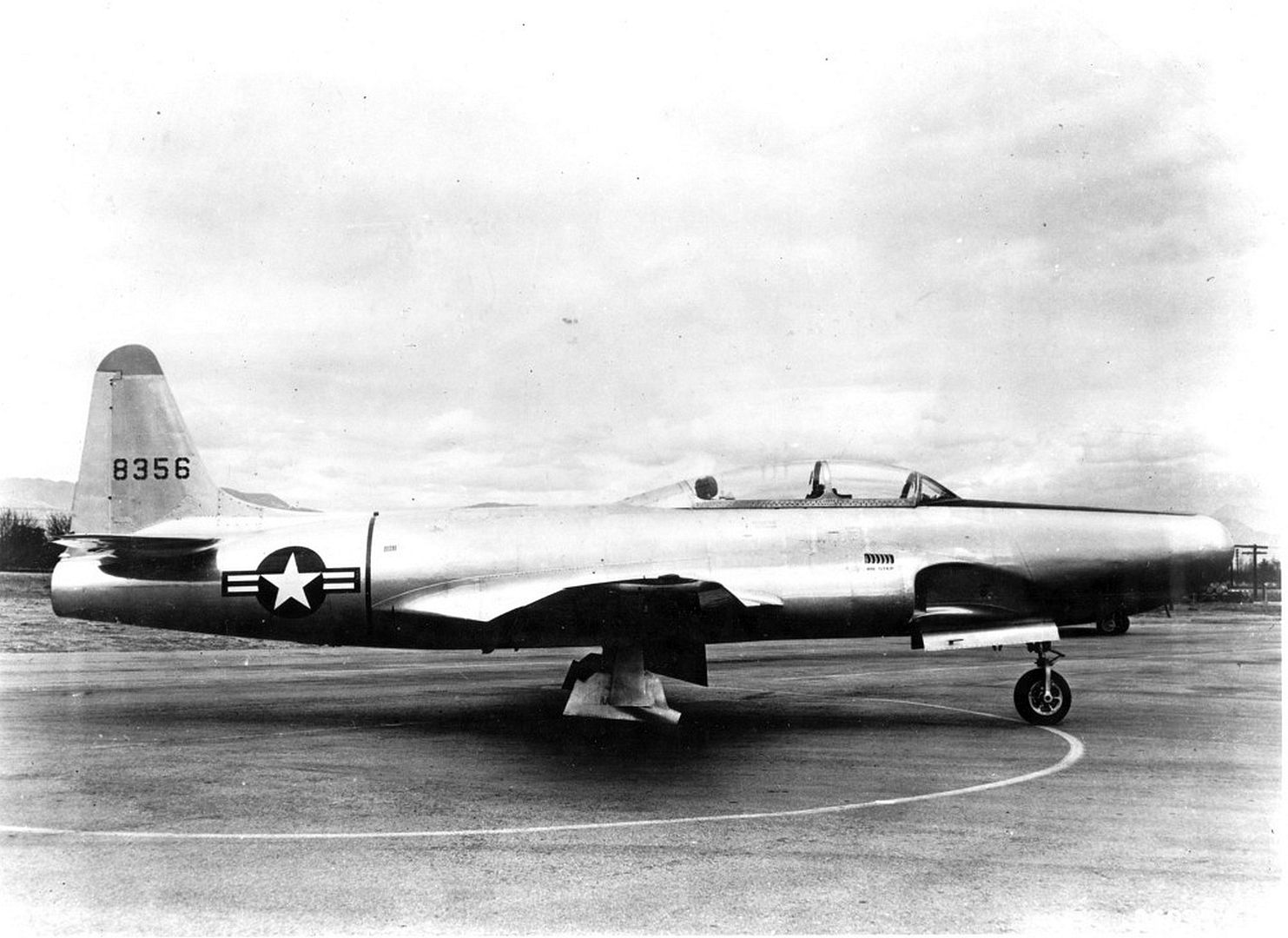

Initial flight tests proved that the handling characteristics were generally satisfactory, but lots of problems cropped up with the afterburner. At that time, afterburners were a relatively new innovation, and there were lots of bugs that had to be ironed out. The engine of the YF-94 suffered from frequent flameouts, often with very difficult relights. These problems were eventually solved by Allison and Lockheed engineers working together to develop a new flame-holder system for the afterburner. The solution to the afterburner problems resulted in the F-94 being cleared for full production and service.
The first production version was the F-94A. One hundred and nine examples had been ordered in January of 1949. Despite reduction of the Air Force budget that occurred as a result of the FY 1949 budgetary crisis, the F-94 procurement quickly rose to 288. The Soviet detonation of an atomic bomb in August 1949 resulted in yet another increase in F-94 procurement to 368 aircraft.
The F-94A was generally similar to the YF-94s, but carried full operational equipment. The seventeen F-94A-1-LOs were practically hand-built models constructed from T-33 airframes taken over from the production line, but the remainder were started on the production line as F-94As. The nose of the F-94A housed four 0/5-inch machine guns with 300 rounds each. The belted ammunition was carried in boxes mounted just head of the cockpit firewall and just behind the avionics boxes. The machine gun armament could be supplemented by a pair of 1000-pound bombs for night bombing missions. A 165 US-gallon teardrop-shaped droptank could be carried underneath each wingtip.
The first F-94A was accepted by the USAF in December of 1949. A total of 109 were built before production switched to the more reliable F-94B model. The F-94A was the first production fighter to be equipped with an afterburner as standard equipment, and it was the first jet-powered all-weather interceptor to serve with the USAF. The F-94A began replacing the North American F-82 Twin Mustangs of the 317th Fighter Interceptor Squadron at McChord AFB in Washington and the 319th Fighter Interceptor Squadron at Moses Lake AFB in Washington in May of 1950.
However, the F-94As proved to be rather troublesome in service, being fraught with engine and electronics problems. The afterburning Allison J-33 engine suffered from frequent turbine blade failures and the fuel system was quite unreliable. The aircraft was unstable and hard to maneuver at high altitude. The pilot and radar operator found that the cockpit was too narrow for them to be able to get in and out of the aircraft quickly during alerts and scrambles. The clearance for the ejection seats was too small, resulting in several tragic accidents during emergency ejections. The fire control radar was quite quirky and unreliable, and the crew members could never be sure that if their system was working at the beginning of a flight that it would still be functional at the end. With the Hughes E-1 fire control system, attacks and firing passes were actually made from the old "pursuit curve" type of attack which resembled a "tail chase" more than a 90-degree, lead collision type of firing pass. The radar gunsight was used to fire at the target aircraft once it was in range. Unfortunately, this exposed the attacking aircraft to the target aircraft's defensive firepower for a rather long period of time.
During service, the early one-piece canopy of the F-94A was replaced by a canopy with a bow frame in the center between the two crew members. This feature was eventually adopted for all subsequent F-94 models as well as on the T-33 trainer. The original under-wing tip tanks were replaced in service by Fletcher centerline tip tanks with a capacity of 230 US gallons each. Some F-94As were fitted with a pod mounted on the leading edge of each wing which carried a pair of 0.50-inch machine guns, bringing the total forward-firing armament to eight machine guns.
The prototype YF-94 (48-356) is on display at Lackland AFB in Texas.
Serials of the F-94A:
ETF-80C->ET-33A 48-356 and 357 converted to YF-94
49-2479/2495 Lockheed F-94A-1-LO
49-2479/2495 Lockheed F-94A-1-LO
49-2496/2588 Lockheed F-94A-5-LO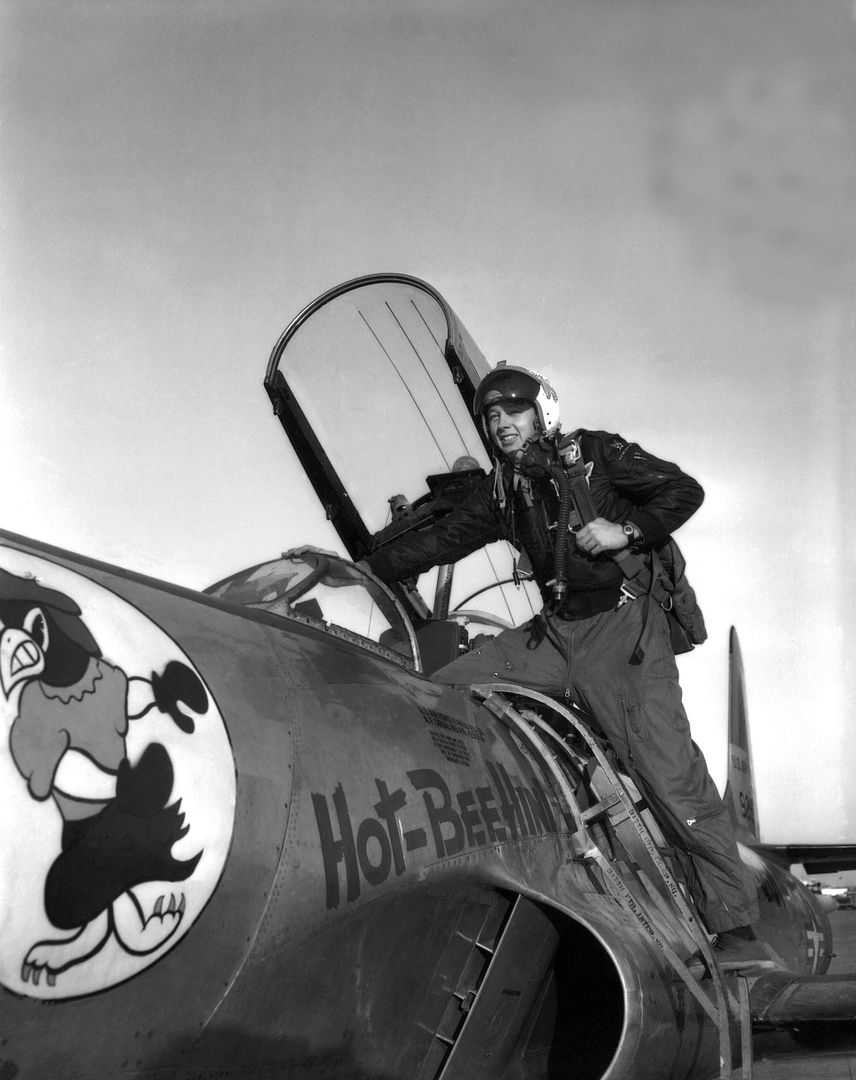


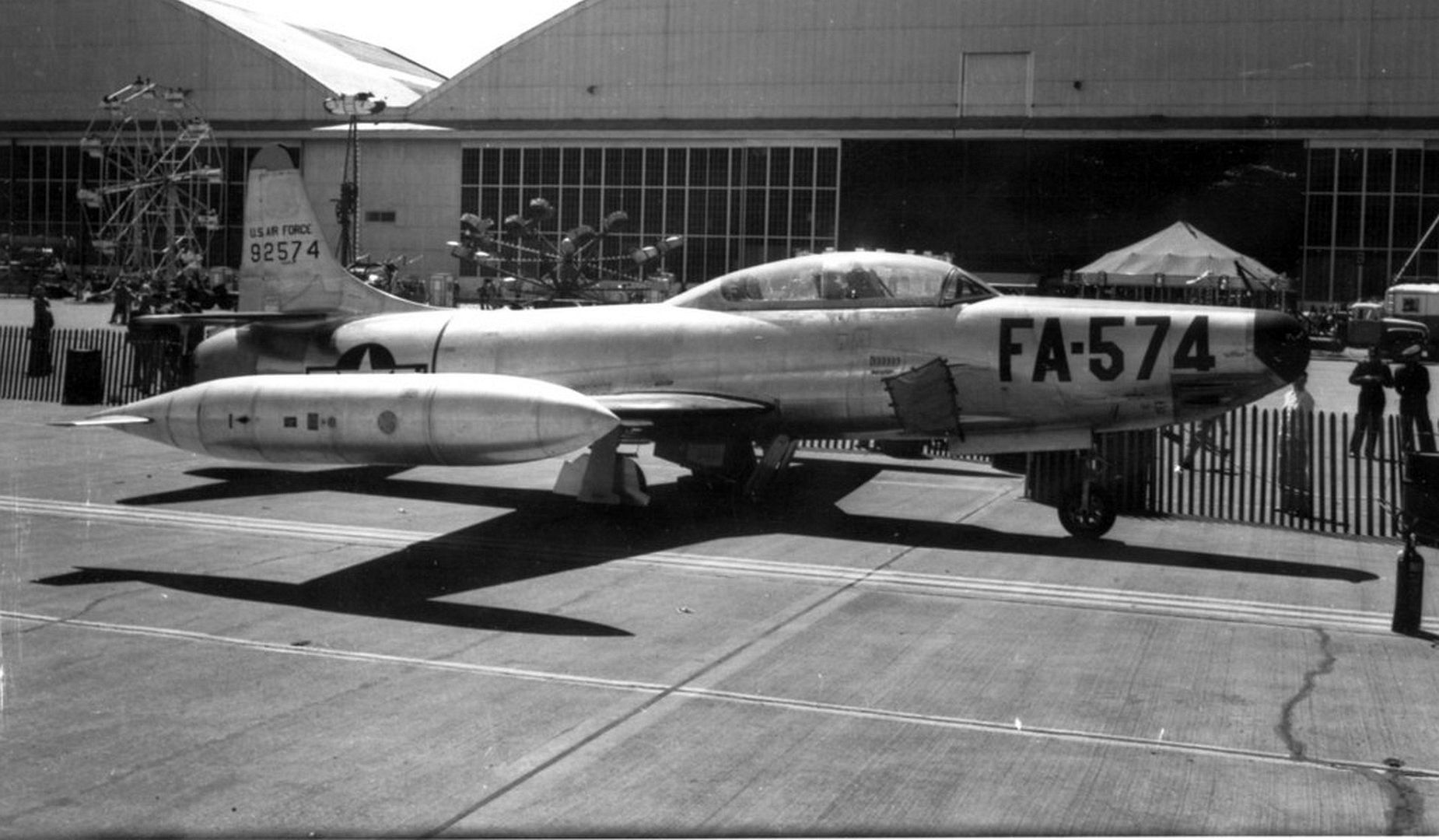

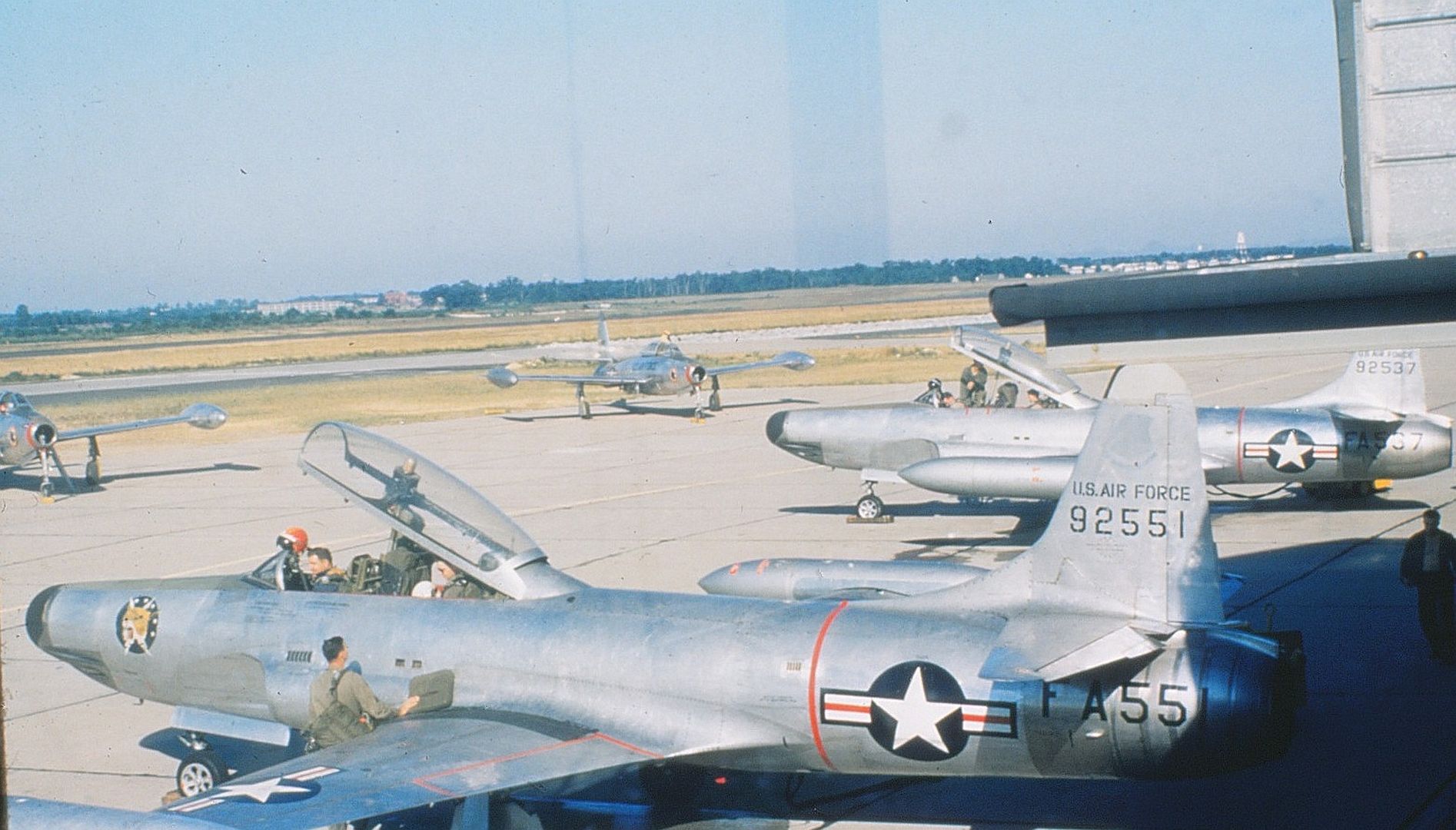

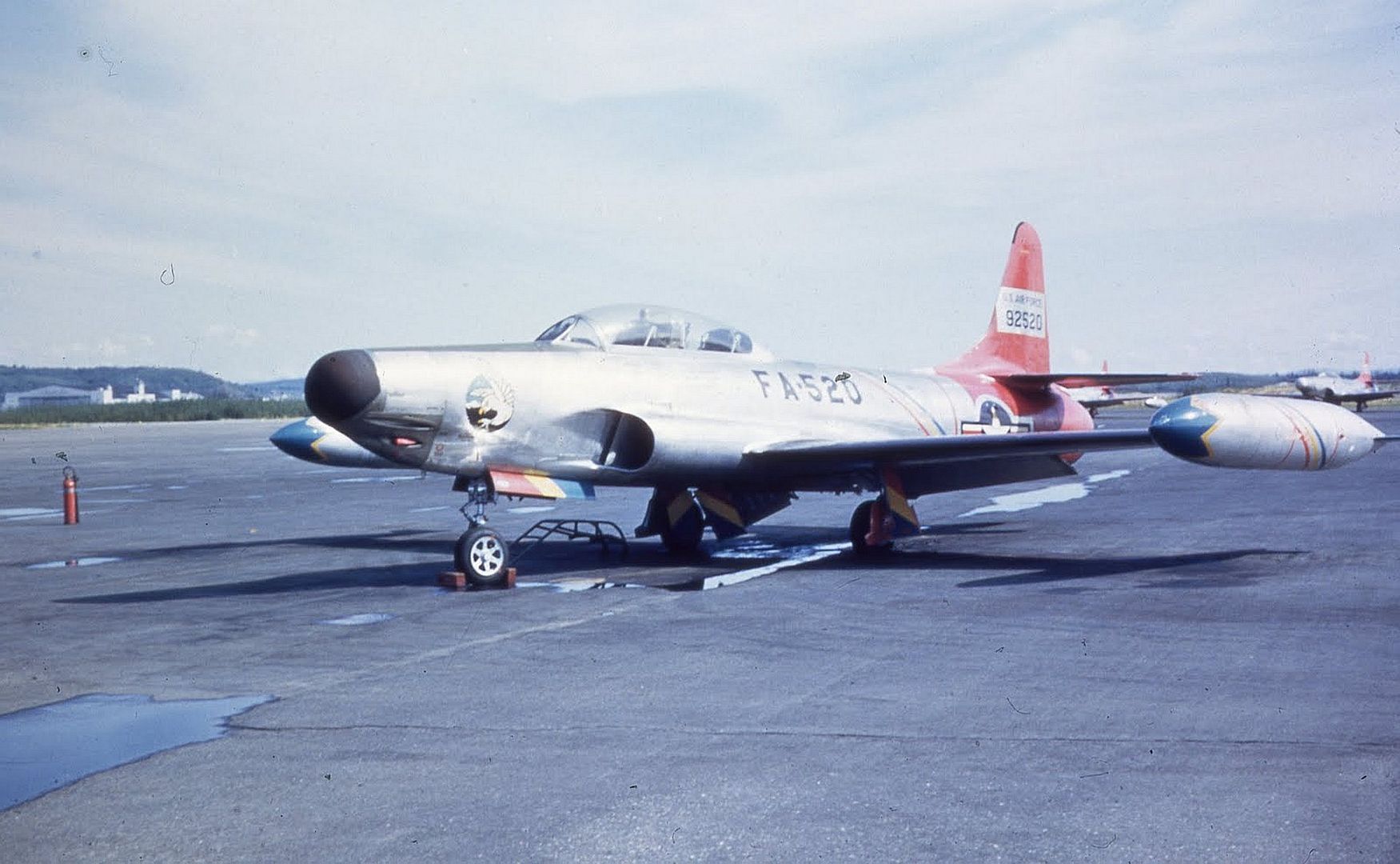
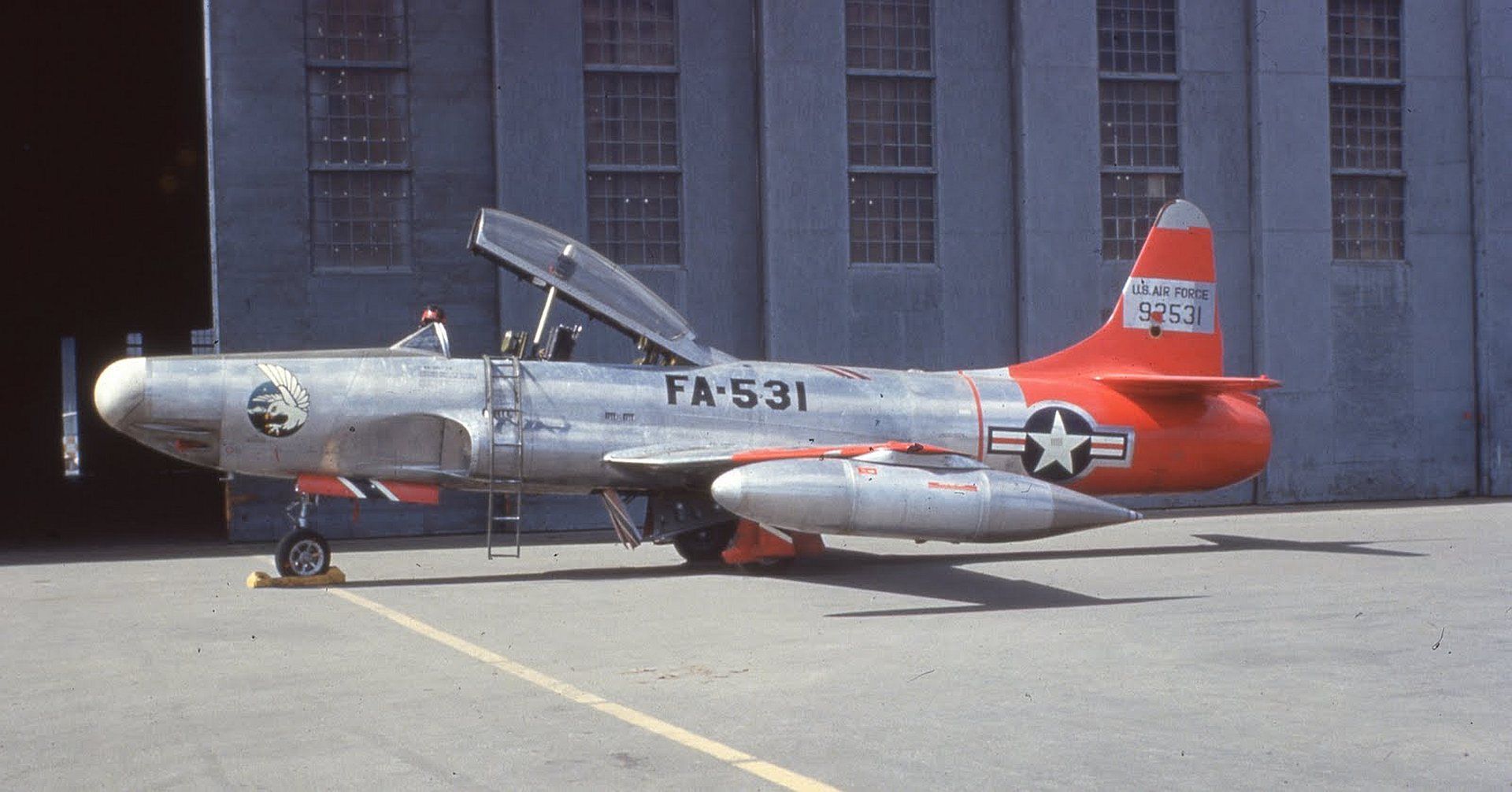
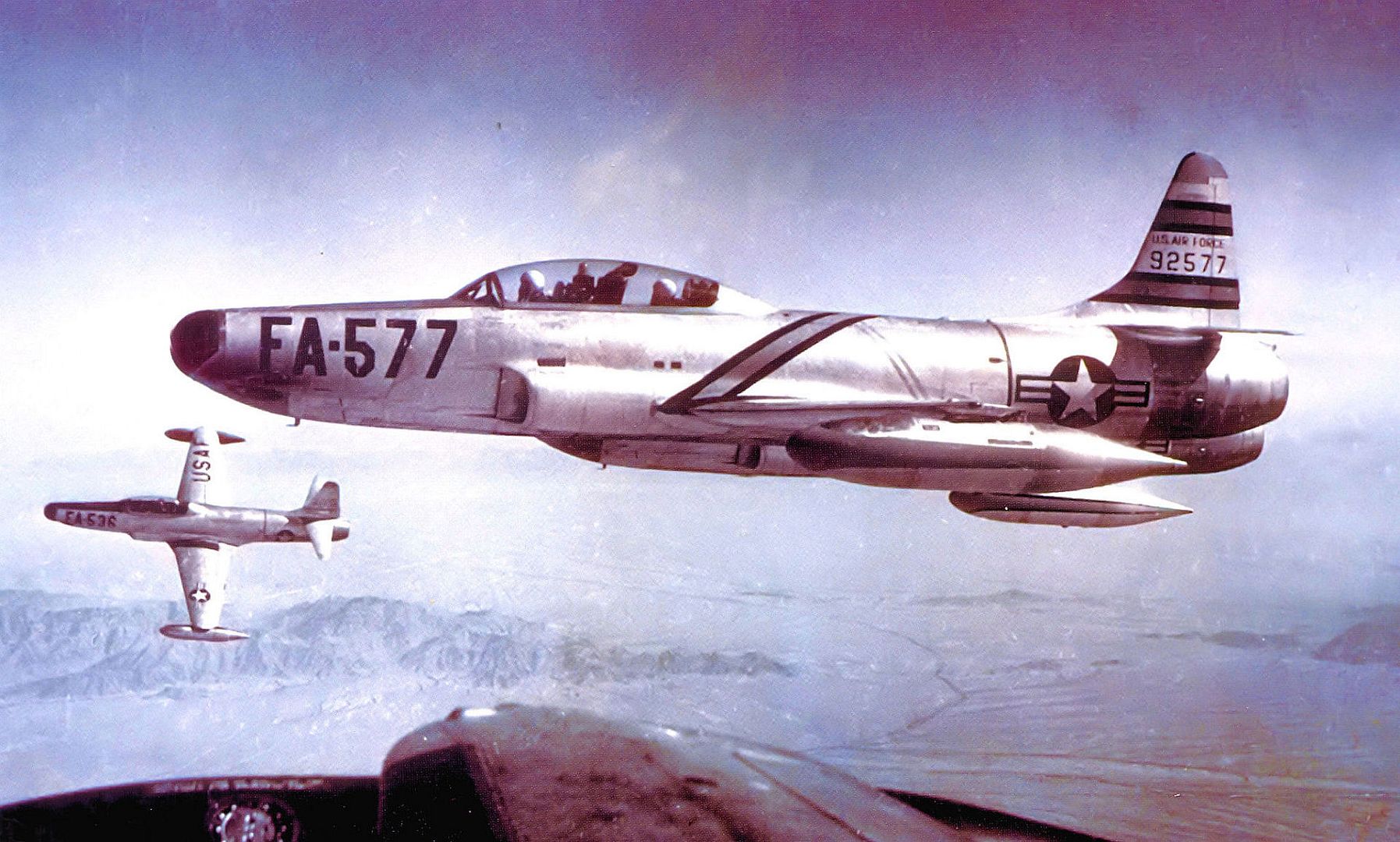
Lockheed F-94B
The next production version of the F-94 series was the F-94B. The F-94B was outwardly virtually identical to the F-94A, differing primarily in having improved internal equipment and systems.
The nineteenth F-94A airframe (49-2497) was modified during production as a testbed for these new and improved systems, the aircraft being redesignated YF-94B. These items included a Sperry Zero Reader which could be coupled to the ILS indicator to give the pilot an in-cockpit reading of his glide slope for bad-weather landings, an improved hydraulic system, and a high-pressure oxygen system. The pilot was provided with a more roomy cockpit. The Fletcher center-line wingtip tanks were adopted as standard.
The YF-94B flew for the first time on September 28, 1950. The first F-94B-1-LO was delivered to the USAF in January of 1951. The F-94B-5-LO differed by being equipped for Arctic service.
The first F-94B reached service in April of 1951 with the 61st Fighter Interceptor Squadron based at Selfridge AFB in Michigan. A total of 356 F-94Bs were built. The F-94B cured most of the engine and electronics reliability problems experienced by the F-94A, and proved in service to be a thoroughly reliable aircraft with relatively few vices and shortcomings.
Service use of the F-94A/B was primarily with the Continental Air Command, which had been set up in December of 1948 as an overall command structure to cover the Air Defense Command, the Tactical Air Command, plus some fighter squadrons that had previously been assigned to the Strategic Air Command. The F-94A/B also flew with the Alaskan Air Command, protecting the USA from Soviet bombers flying in from Siberia. For three years between 1950 and 1953, the F-94A/B played a vital role in the defense of the continental United States from attack by nuclear-armed Soviet Tu 4 bombers. It was the only jet-powered all-weather interceptor available in quantity at that time, and filled in a vital gap until more advanced equipment could be provided. After wringing out some initial bugs, the F-94A/B interceptors proved to be quite reliable and relatively easy to maintain in the field. However, the F-94A/B lacked sufficient range and adequate climbing speed to make it a really good interceptor, and its armament did not pack sufficient punch to be considered really effective against bombers.
Although in retrospect the Soviet long-range bomber threat of the early 1950s was greatly exaggerated, this does not take anything away from the F-94A/B, which was able to serve with distinction when nothing else was available.
The F-94B was the first *American* jet-powered all-weather fighter to enter combat (the radar-equipped Messerschmitt Me 262B of the German Luftwaffe was actually the first jet-powered night fighter to participate in combat, taking part in the last-ditch defense of Berlin in March of 1945). The first F-94As to reach the Far East Air Force (FEAF) arrived at Itazuke AFB in Japan in March of 1951, equipping the 68th Fighter Interceptor Squadron. They were deployed to Japan primarily to guard US bases in Japan against attack by Soviet bombers. By the end of 1951, this squadron began posting two F-94s on strip alert at Suwon AFB in Korea. They were to be scrambled in case any enemy night intruders came South. During the Korean War, similar duty was carried out by the 339th Fighter Interceptor Squadron, which converted from F-82Gs to F-94Bs in 1951 at Chitose. The 319th Fighter Interceptor Squadron began operating F-94Bs from Suwon on March 22, 1952.
Initially, the F-94s operating in Korea were there only to protect their bases from night-flying enemy intruders. They were forbidden to operate over enemy territory, lest their sensitive radar fire control systems fall into enemy hands. However, mounting losses of B-29 bombers following the Chinese and North Korean development of night interception tactics finally led to the lifting of this restriction in January of 1953. In that month, the F-94s of the 319th Fighter Interceptor Squadron began flying defensive patrols in advance of the night-flying bombers. On the night of January 30, 1953, an F-94B flown by Capt B. L. Fithian as pilot and Lieut S. R. Lyons as radar operator shot down an unseen Lavochkin La-9 piston-engined fighter, scoring first blood for the F-94B. The Korean-based F-94Bs destroyed three more enemy aircraft during the next six months, but one F-94B was destroyed on the night of June 12 when it collided with a Polikarpov Po-2 biplane.
F-94B-5-LO serial number 51-5502 was modified to test the radar and guidance system of the F-99 (later IM-99) Bomarc missile. The radar and armament in the nose were deleted and replaced by the needle-shaped nose of the Bomarc, making the nose aout 17 feet longer. The longer nose required that additional equipment and ballast be added to the rear of the aircraft. The aircraft was redesignated NF-94B.
Two F-94Bs (51-5500/5501) were modified to become aerodynamic test prototupes for the proposed F-94D ground attack version, and were redesignated YF-94D.
Three Air National Guard units, the 121st FIS (DC ANG), the 142nd FIS (Maine ANG) and the 148th FIS (Pennsylvania ANG), operated the F-94A/B while they served on active duty during the Korean War call-up. However, these F-94s were retained by the USAF when these ANG squadrons returned to State control on October 31, 1951.
The A and B versions of the F-94 were phased out of USAF squadrons by mid-1954 as more advanced interceptors such as the Northrop F-89C/D Scorpion and the North American F-86D Sabre became available in quantity. As they left USAF service, they were passed along to Air National Guard units. F-94A/Bs reentered ANG service in June of 1953 when they replaced F-51H Mustangs in the 137th FIS of the New York ANG. Before being transferred to the ANG, the F-94A/Bs had their cockpits widened to improve the chance of a successful ejection in the event of trouble. The original narrow cockpit had resulted in several unfortunate accidents during emergency ejections.
In ANG service, a number of F-94As were fitted with a twin-gun pod on each wing leading edge. Each pod carried a pair of forward-firing Browning M3 0/50-inch machine guns. This brought the total number of forward-firing 0.50-inch machine guns to eight. The mid-wing pods created very little additional drag and increased the loaded weight only slightly.
The F-94A/B served with the following ANG squadrons: 101, 102, 103, 109, 114, 116, 118, 123, 131, 132, 133, 134, 136, 137, 138, 139, 175, 178, 179, 180, and 190. The last F-94A/Bs left ANG service in 1959.
A design study for a two-seat radar combat trainer based on the F-94B was initiated under the company designation L-199, but it never got past the drawing board.
Serials of the F-94B:
49-2497 Lockheed YF-94B
50-805/876 Lockheed F-94B-1-LO
50-878/954 Lockheed F-94B-1-LO
51-5307/5512 Lockheed F-94B-5-LO
Specifications of the F-94B:
One Allison J33-A-33 or -33A turbojet rated at 4400 lb.st. dry and 6000 lb.st with afterburning. Wingspan 37 feet 6 inches (38 feet 11 inches with wingtip tanks), length 40 feet 1 inches, height 12 feet 8 inches, wing area 234.8 square feet. Weights: 10,064 pounds empty, 13,474 pounds loaded, 16,844 pound maximum. Maximum speed 606 mph at sea level. Initial climb rate 6850 feet per minute. Service ceiling 48,0-00 feet. Normal range 665 miles, maximum range 905 miles. Armed with four 0.50-inch M-3 machine guns in the nose.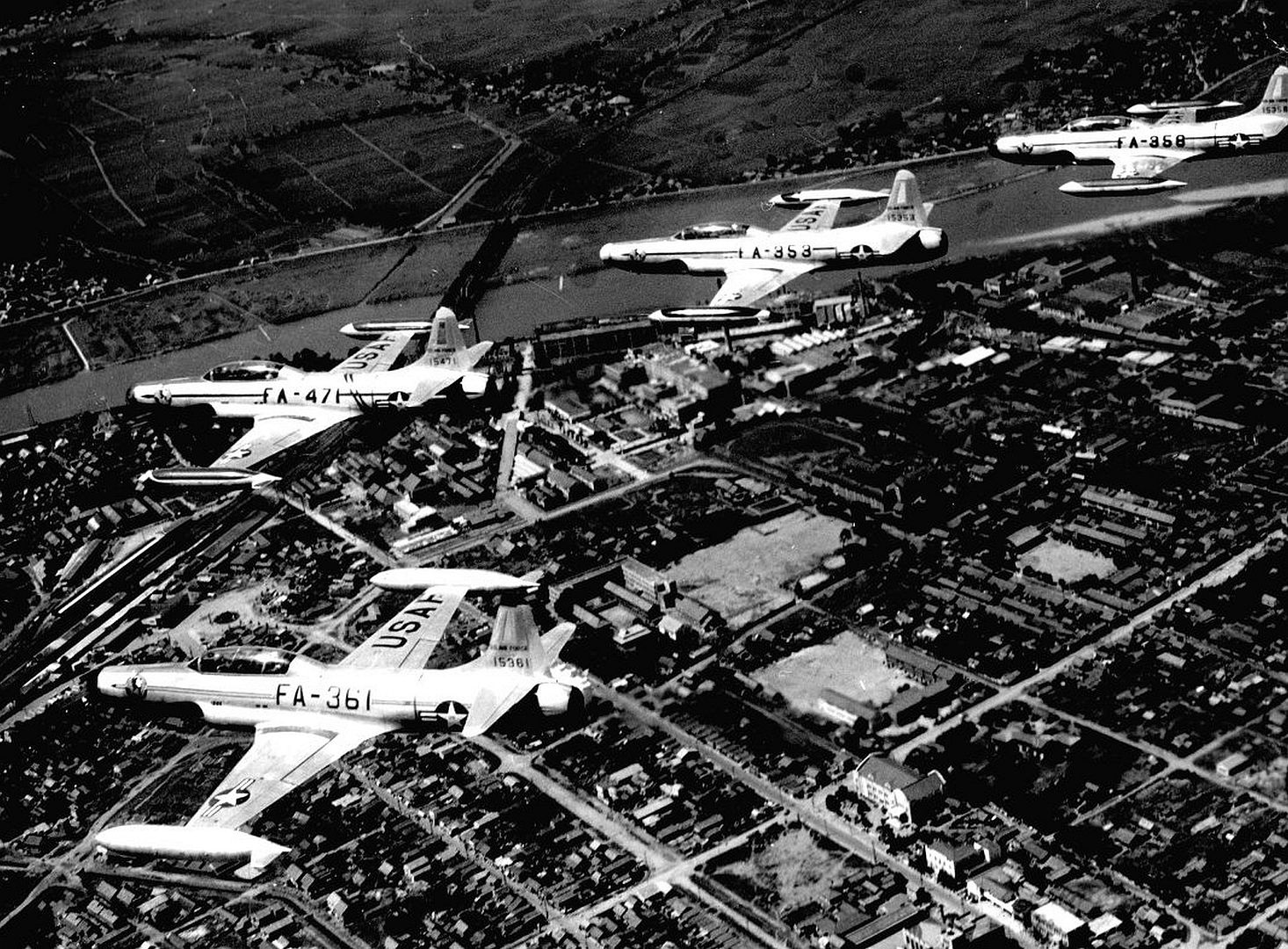
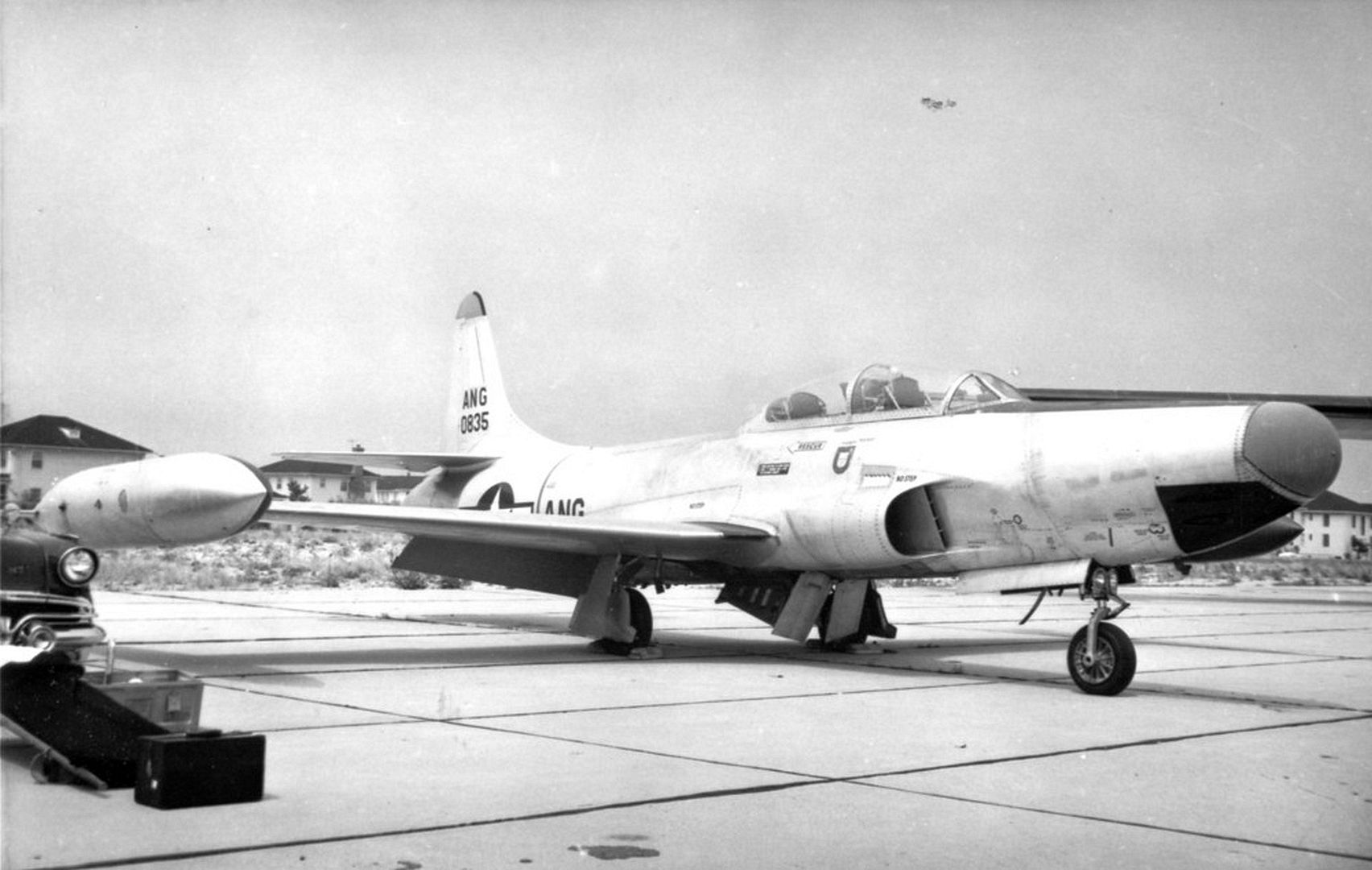
_from_the_319th_Fighter_Interceptor_Squadron_in_Korea_1953..jpg?width=1920&height=1080&fit=bounds)
_Lewis_Research_Center_in_Cleveland_Ohio..jpg?width=1920&height=1080&fit=bounds)
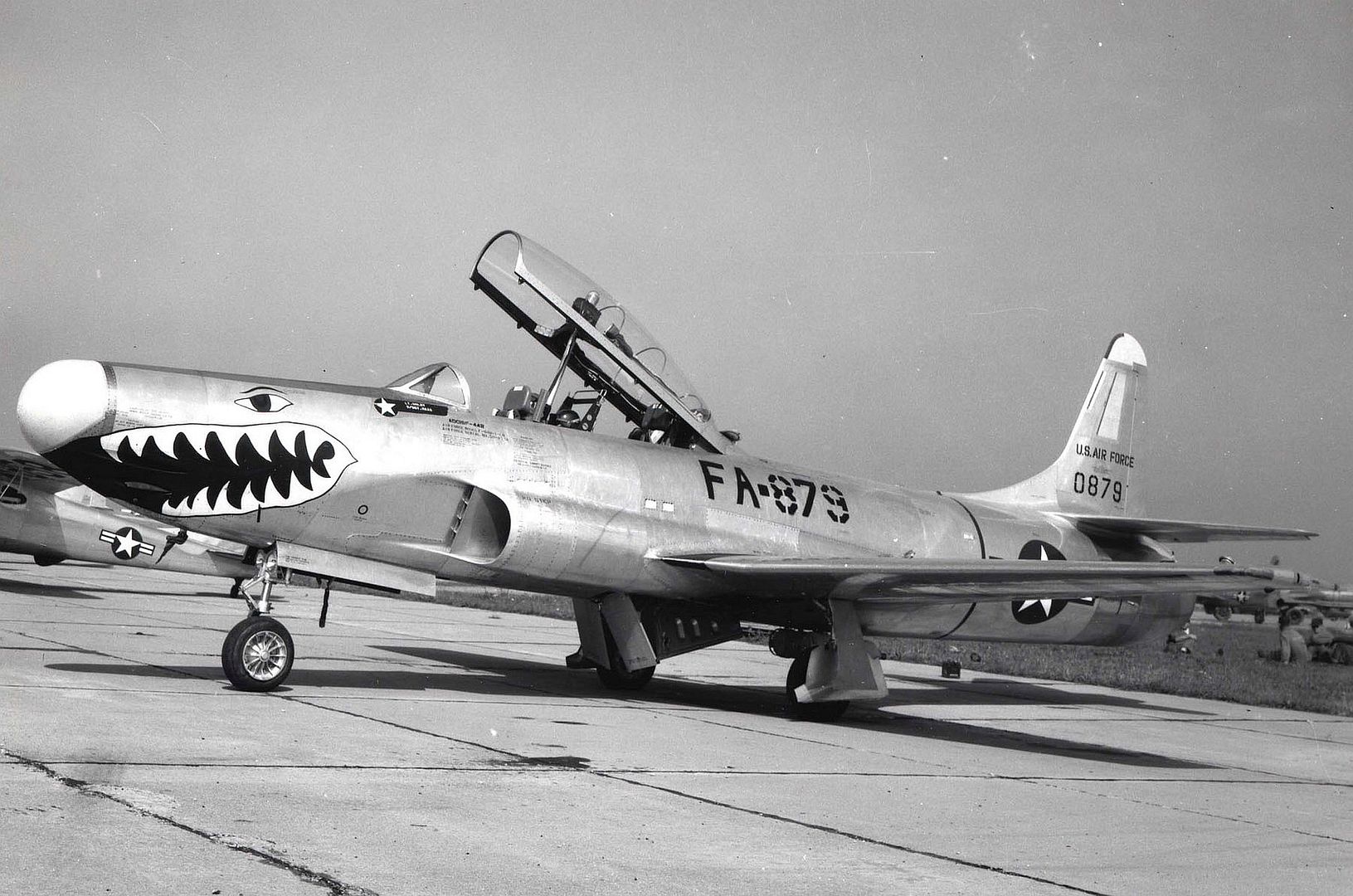



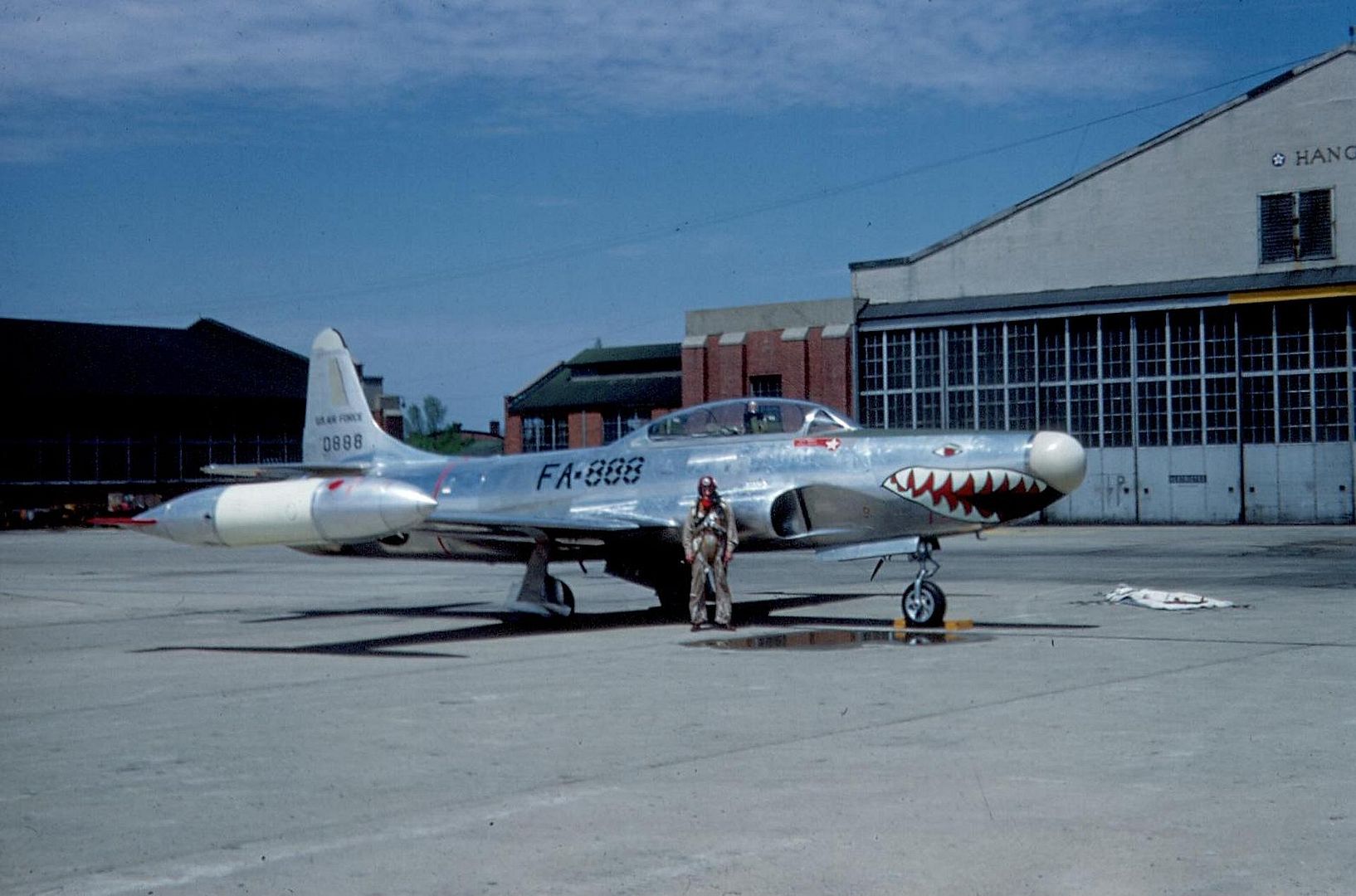
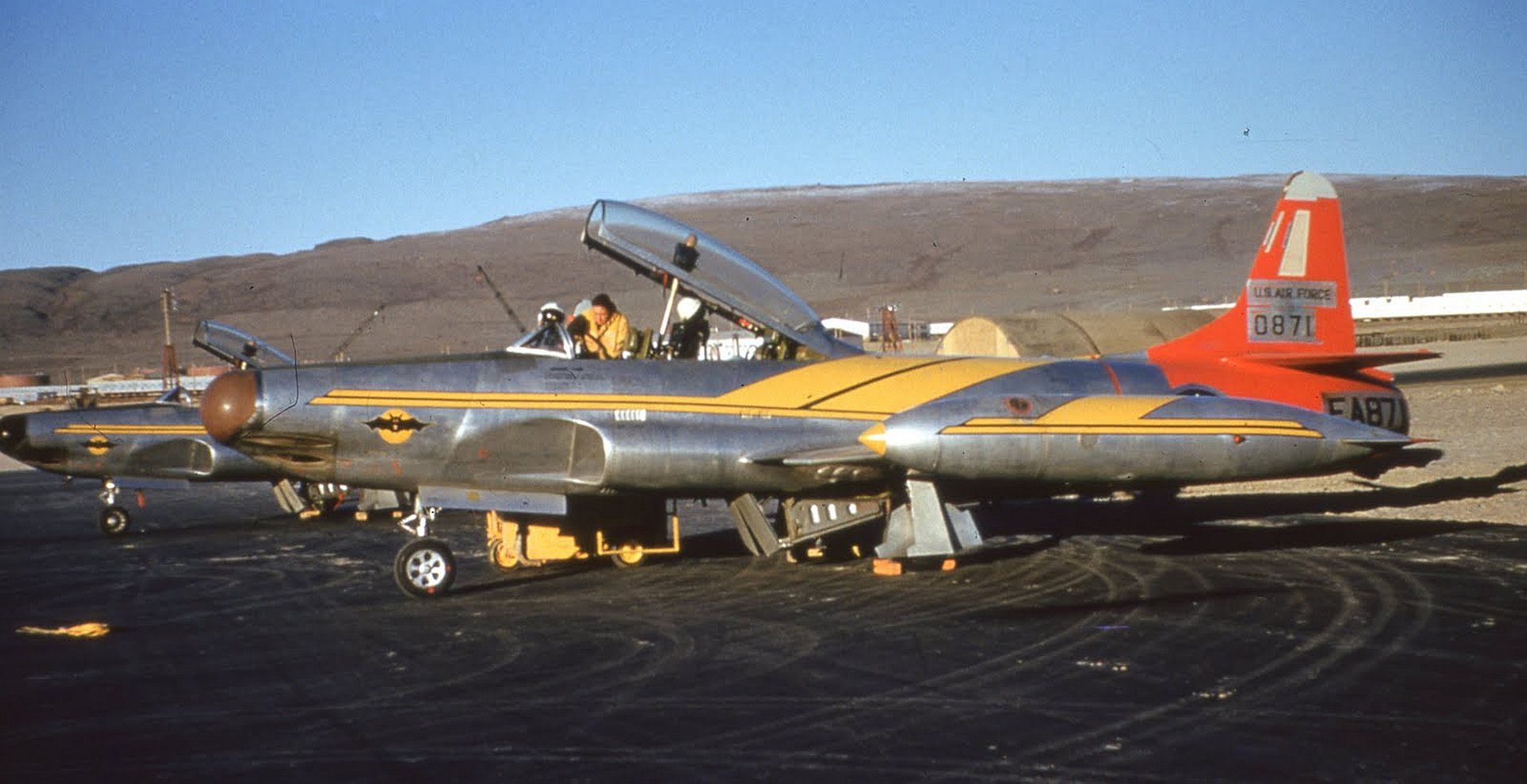
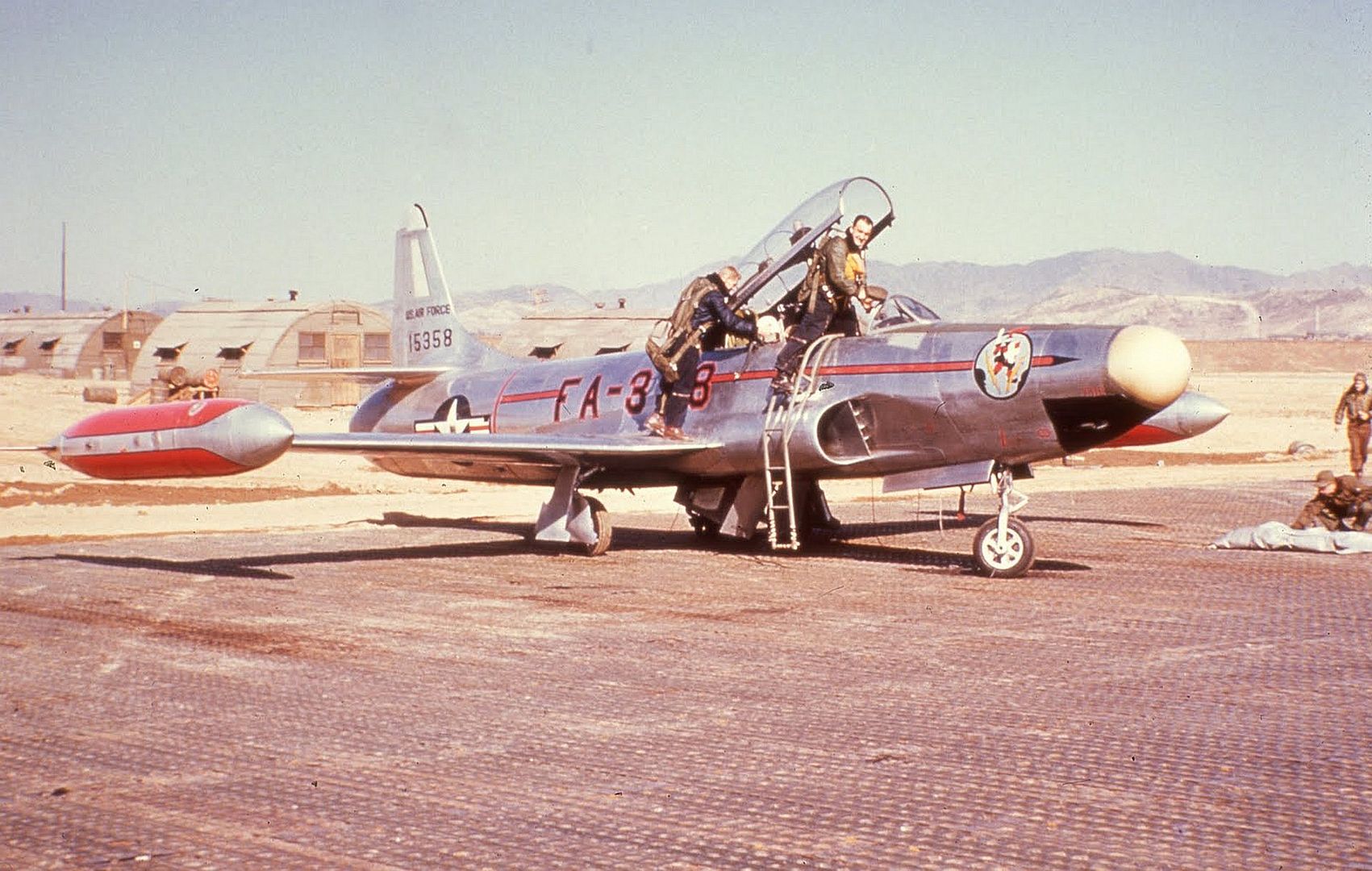
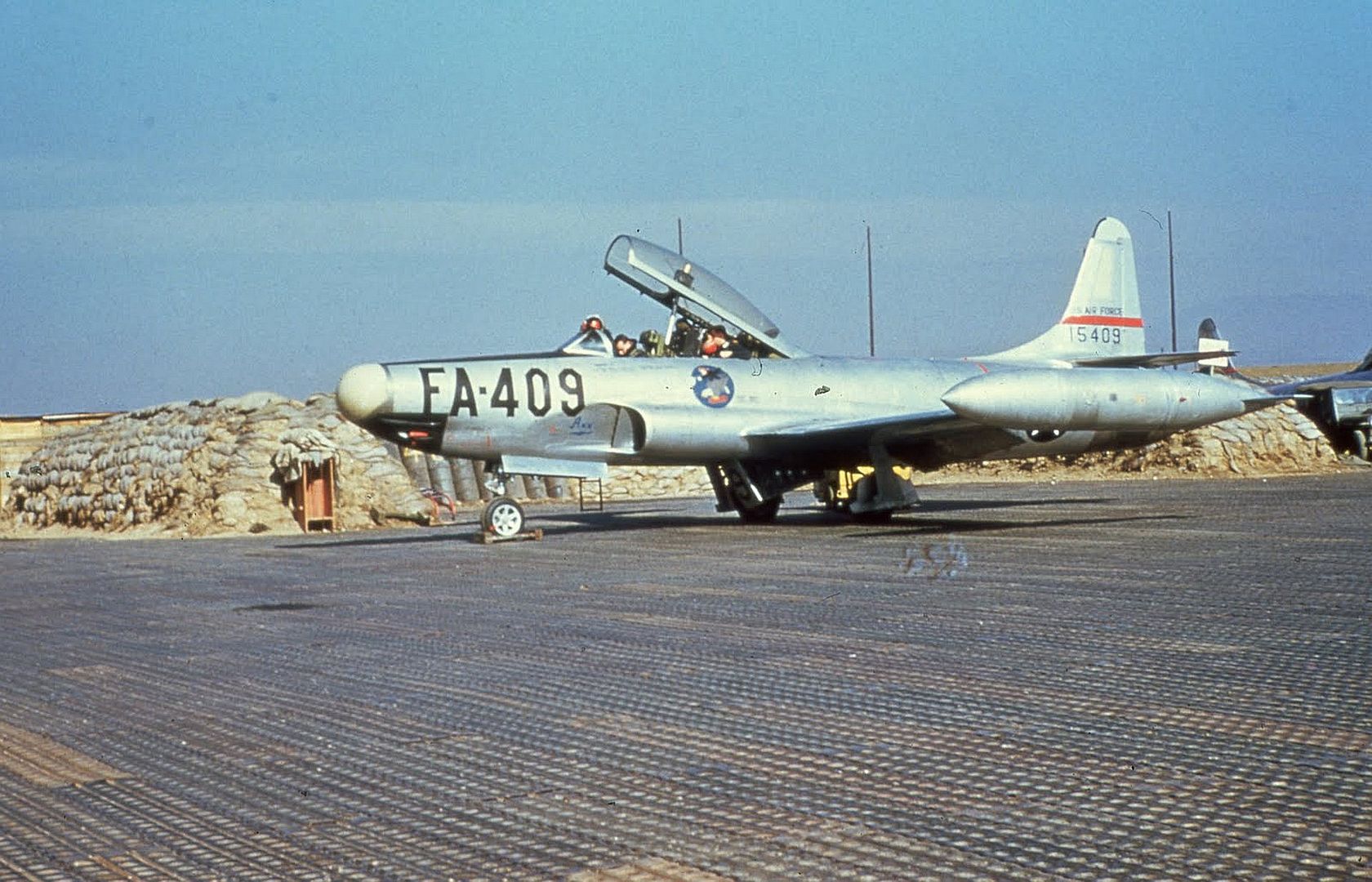
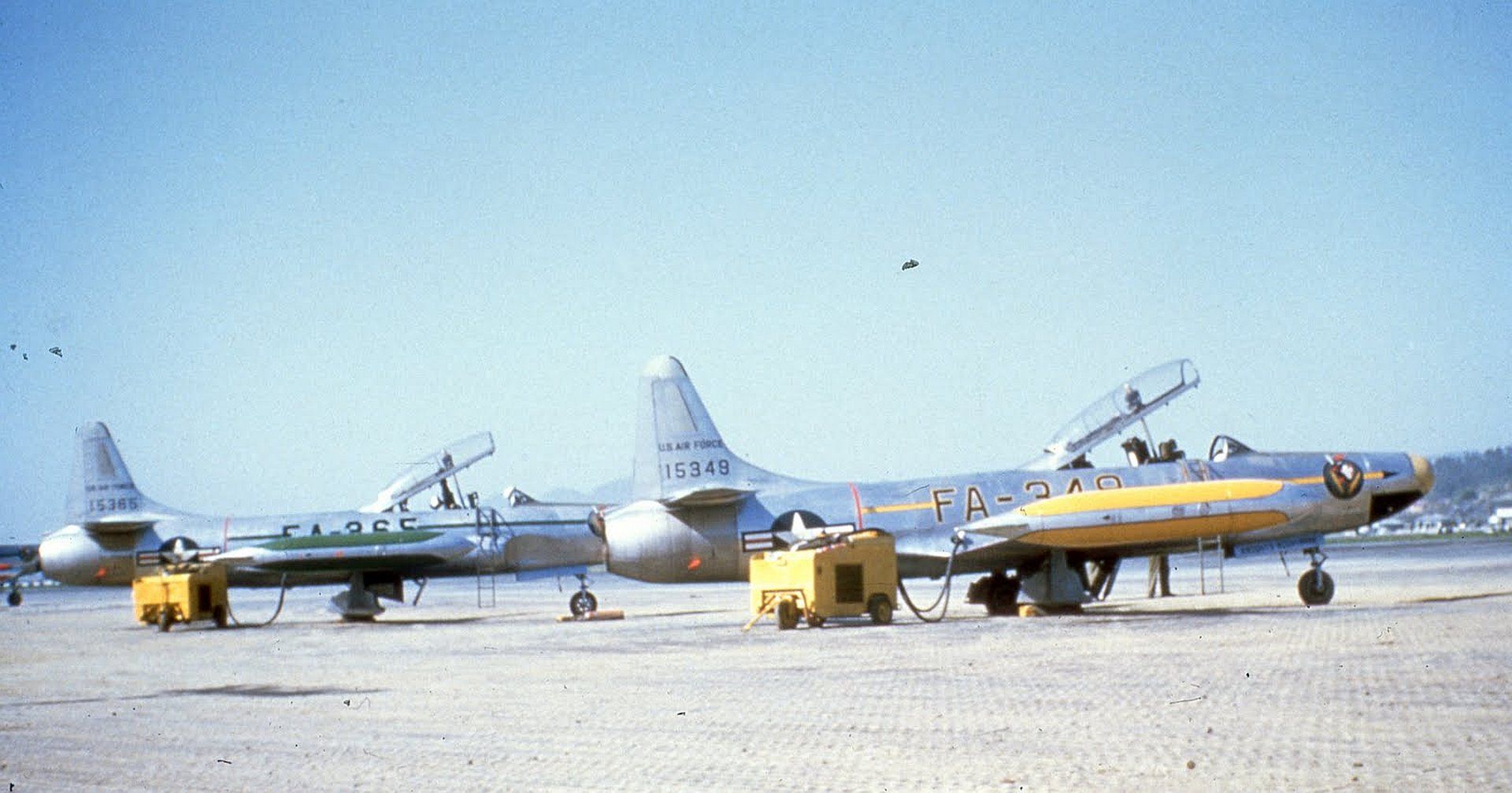
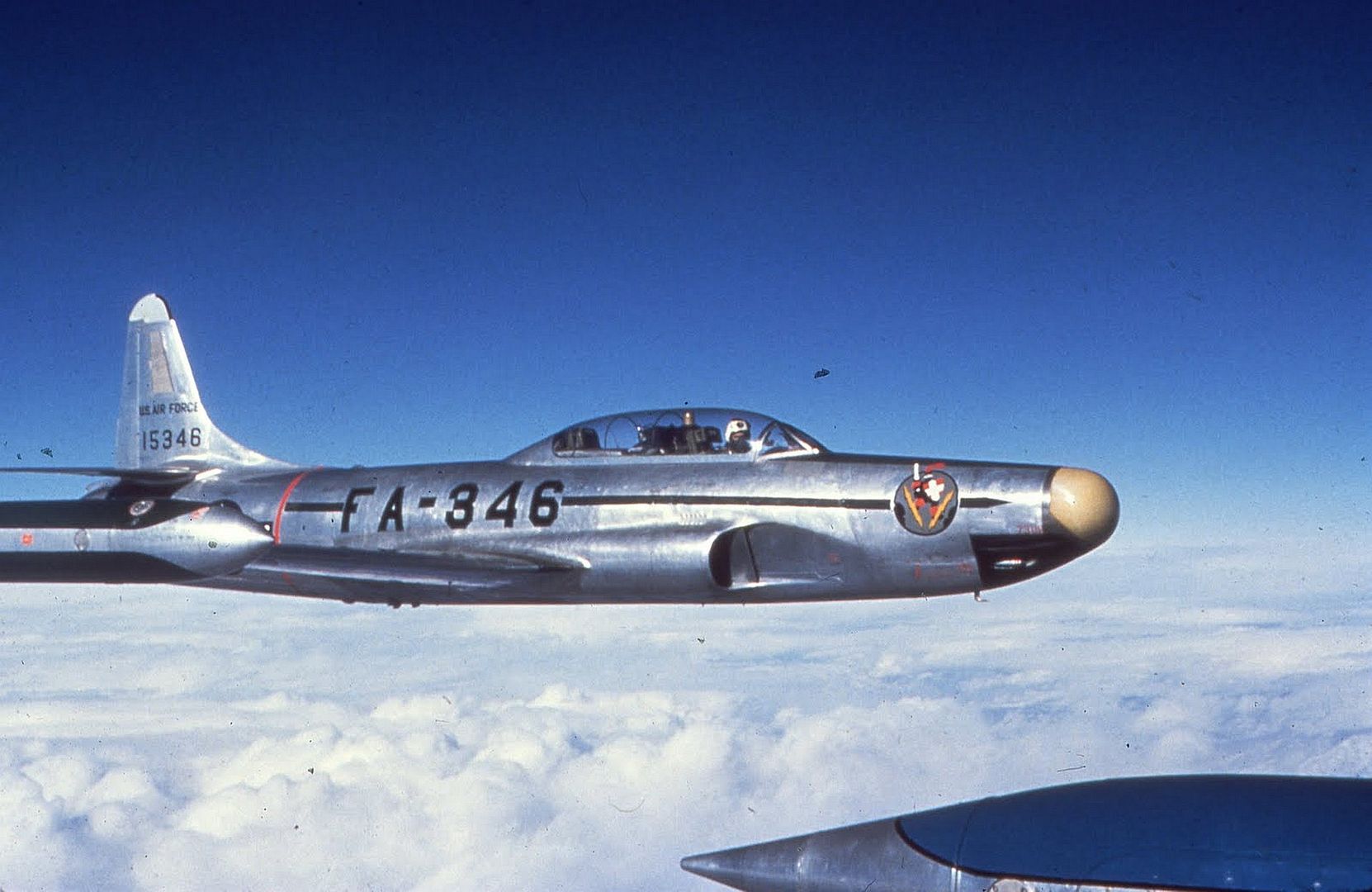

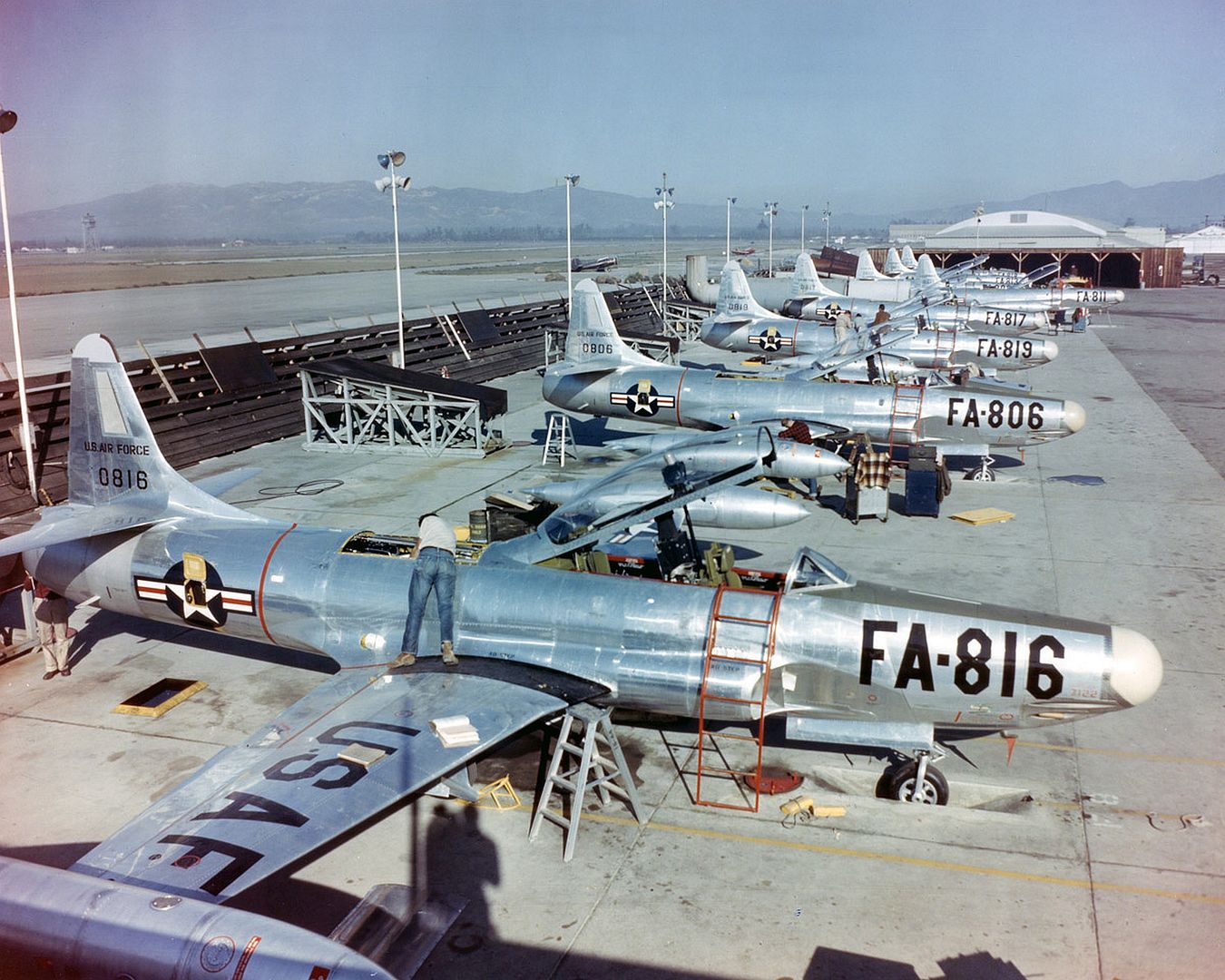
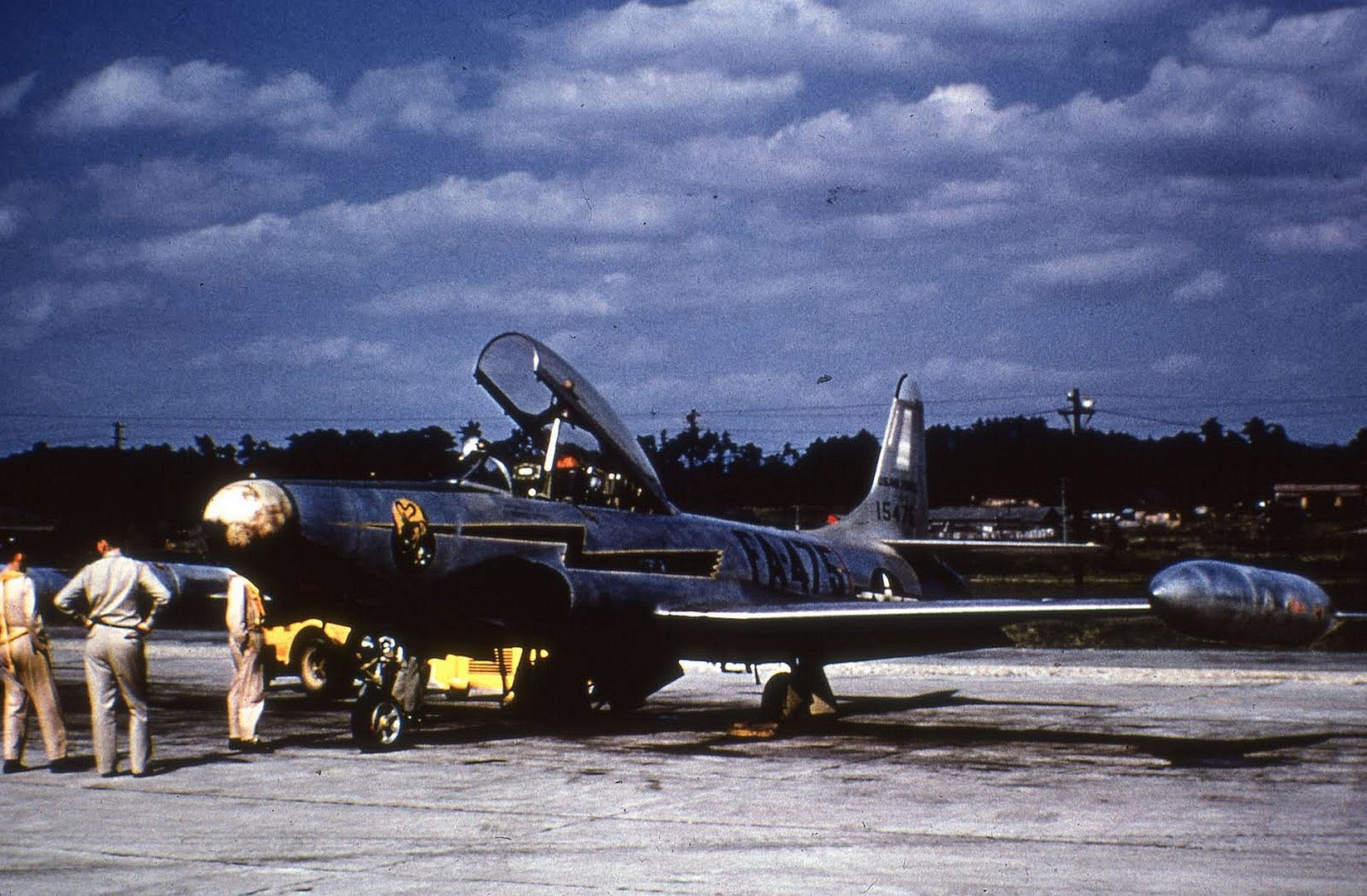

Lockheed F-97/F-94C Starfire
The F-94A/B all-weather interceptors of the USAF were considered only as interim types which would fill in the gap for a couple of years until more advanced aircraft could be made available in quantity. Once their initial problems had been corrected, the F-94A/B proved to be quite reliable all-weather interceptors and were relatively easy to maintain in the field. However, the F-94A/B lacked sufficient range and climbing speed to make it a really good interceptor, and its armament did not pack sufficient punch to be considered really effective against bombers.
In July 1948, four months before receiving the contract for the first batch of F-94As, Lockheed issued a proposal to the USAF for a more advanced development of the F-94A concept. The project was given the company designation of L-188. In order to achieve higher Mach numbers, the L-188 featured a completely new wing with reduced thickness and greater dihedral. The speed brakes were revised and the fuel capacity was increased. The aircraft was to be provided with a drag 'chute, being the first USAF fighter to be so equipped. Since more power was clearly needed, a Pratt & Whitney J48 afterburning turbojet was to be fitted. This engine was a license-built version of the British-designed Rolls-Royce Tay. With afterburning, this engine offered 8750 pounds of thrust. The increased engine thrust required that the air intakes be revised and made larger. The rear fuselage had to be revised in order to accommodate this new engine. A more advanced Hughes E-5 fire control system with APG-40 radar was to be used. The machine gun armament of the F-94A was to be replaced by an all-rocket armament mounted in the fuselage nose.
The USAF was initially not all that interested in the Lockheed proposal, preferring to concentrate on the North American F-86D Sabre and the Northrop F-89 Scorpion. Nevertheless, the USAF thought enough of the proposal that they assigned it a designation of F-97. A new F-number was selected for the Lockheed proposal since it was almost a complete redesign of the F-94.
Undeterred by the USAF's initial lukewarm response to their L-188 proposal, Lockheed decided in 1949 to go ahead with the construction of a company-funded demonstrator aircraft that would combine the L-188 wing with a F-94A fuselage from which the military armament and fire control systems had been omitted. Since the J48 engine was not yet ready, the demonstrator was fitted with an imported non-afterburning Rolls-Royce Tay.
Bearing the civil registration N94C, the unarmed demonstrator flew for the first time on January 19, 1950, with test pilot Tony LeVier at the controls. It retained the original nose of the F-94A, and had non-standard teardrop-shaped centerline-mounted wingtip tanks. The USAF was sufficiently impressed that in February 1950 they purchased the unarmed L-188 demonstrator under the designation YF-97. The military serial number 50-955 replaced the original civil registration number. At the same time, the USAF ordered a fully militarized prototype YF-97 under the serial number 50-877. 180 production examples were ordered under the designation F-97A. The company designation for the F-97A was Model 880.
Initial trials with the L-188/YF-97 demonstrator turned up several problems which were corrected by progressive modifications. The wing root extension fillet of the original L-188 wing was removed in order to improve stall characteristics during landing approach. The original horizontal stabilizer of the F-94 was replaced by power-boosted swept surfaces to eliminate an annoying high-frequency vibration that took place at high Mach numbers. Dampers were added to correct aileron buzzing. Spoilers were added to improve roll control. The vertical fin was made larger in order to increase directional stability at high speeds. When the American-built Tay finally became available, the first YF-97 was re-engined with a J48-P-3 engine, rated at 6000 lb.s.t. dry and 8000 lb.s.t with afterburning.
On September 12, 1950, the YF-97 was redesignated YF-94C. Even though the YF-97 was almost a completely new aircraft, it was thought wise to pretend that the design was simply a "logical extension" of an existing aircraft. Political considerations often play an important role in the choice of aircraft designations.
The name Starfire was applied to the F-94C by publicists, following the tradition of naming Lockheed aircraft after celestial objects. The C-variant was the only variant in the F-94 series to carry this name.
The two YF-94Cs continued to be used for tests of the improved fire control system and the all-rocket armament. The all-rocket armament consisted of twenty-four 2.75-inch Folding-Fin Aircraft Rockets (FFAR) mounted in four groups surrounding the APG-40 radome in the nose. The rockets in each group were mounted inside a door which opened sideways on the ground for easy servicing and reloading. In front of each rocket group was a snap-action door which opened immediately before firing. The YF-94Cs were fitted with a revised fuel system accommodating 566 US gallons in wing and fuselage tanks, 500 gallons in center-mounted wingtip tanks, and 460 gallons in midwing drop tanks mounted on pylons at the wing center for a total fuel capacity of 1526 gallons. There were difficulties with the drag chute, with the automatic pilot, with the afterburner of the J48, and with aileron flutter. These problems were not fully resolved until after the first F-94C production aircraft had been delivered.
The first production F-94C was delivered in July of 1951. The production F-94C was powered by the Pratt & Whitney J48-P-5 engine rated at 6350 lb.s.t. dry and 8750 lb.s.t. with afterburning. Teething problems delayed the introduction of the F-94C into squadron service for almost two years. The F-94C finally entered service with the 437th Fighter Interceptor Squadron at Otis AFB in Massachusetts in June of 1953. The F-94C was the second type of fighter serving with the Air Defense Command (ADC) to use rockets as its sole armament, the North American F-86D Sabre being the first.
Initially, the F-94C suffered with some of the same teething troubles which had not been completely ironed out during the testing of the YF-94Cs. The E-5 fire control system had reliability problems. The cockpit seal tended to leak, causing electrical short-circuits. In addition, the jet engine tended to flame out when the nose rockets were fired. However, once these difficulties were cleared up, the F-94C became popular with its flight and maintenance crews. The rocket armament of the F-94C was considered to be more accurate than that of the F-86D Sabre, owing to the use of closed-breech launchers by the F-94C which increased the velocity of the rockets. However, the firing of the nose rockets violently shook the F-94C and blinded both crew members in exhaust smoke and fire.
387 F-94C aircraft were built and delivered between July of 1951 and May of 1954. In 1953, F-94Cs were delivered to the 29th, 48th, 66th, 332nd, 438th, and 497th Fighter Interceptor Squadrons. In 1954-55, F-94Cs went to the 27th, 39th, 61st, 64th, and 318th Squadrons. While the 319th FIS was not one of the squadrons to receive the F-94C directly from the factory, they did operate them from March 1956 until transition to the F-89J was completed in December 1957. Most of these squadrons served in the mainland United States, although the 39th did serve for a time in Japan.
In the course of its production and service life, the F-94C was progressively improved and upgraded, with new features continually being added in the field. New and improved ejector seats were provided, variable-position dive brakes were fitted, and a better drag chute was added. Beginning with the 100th F-94C leaving the production line, a twelve-rocket pod was mounted on each wing leading edge, doubling the armament of the Starfire. A frangible plastic nose covered the front of each pod, which shattered when the rockets were fired. These mid-wing rocket pods were retrofitted to earlier production machines. Owing to the crew blinding problem during rocket firing, the nose rockets were often omitted from F-94Cs in the field, the rocket armament being carried exclusively in the mid-wing pods. The nose radome initially had a rather blunt shape, but it was soon replaced by a more pointed radome which quickly became standard.
The F-94C Starfire became the first all-weather fighter to break the sound barrier, which happened by accident when test pilot Herman "Fish" Salmon put his F-94C into a dive from 45,000 feet, rolling over in afterburner.
A single F-94C was used to test the adoption of the Hughes GAR-1 Falcon missile as part of the basic armament of the Starfire. This aircraft was redesignated DF-94C. Although the Falcon missile was never made part of the Starfire's operational armament, these experiments provided data for later generations of ADC interceptors.
F-94C serial number 50-963 was experimentally fitted with an enlarged nose in which reconnaissance cameras were mounted in place of the interceptor's radar and rockets. This plane was redesignated EF-94C, the E standing for *Exempt*. E was used rather than the regular R for Reconnaissance because this aircraft was to be used strictly for research purposes.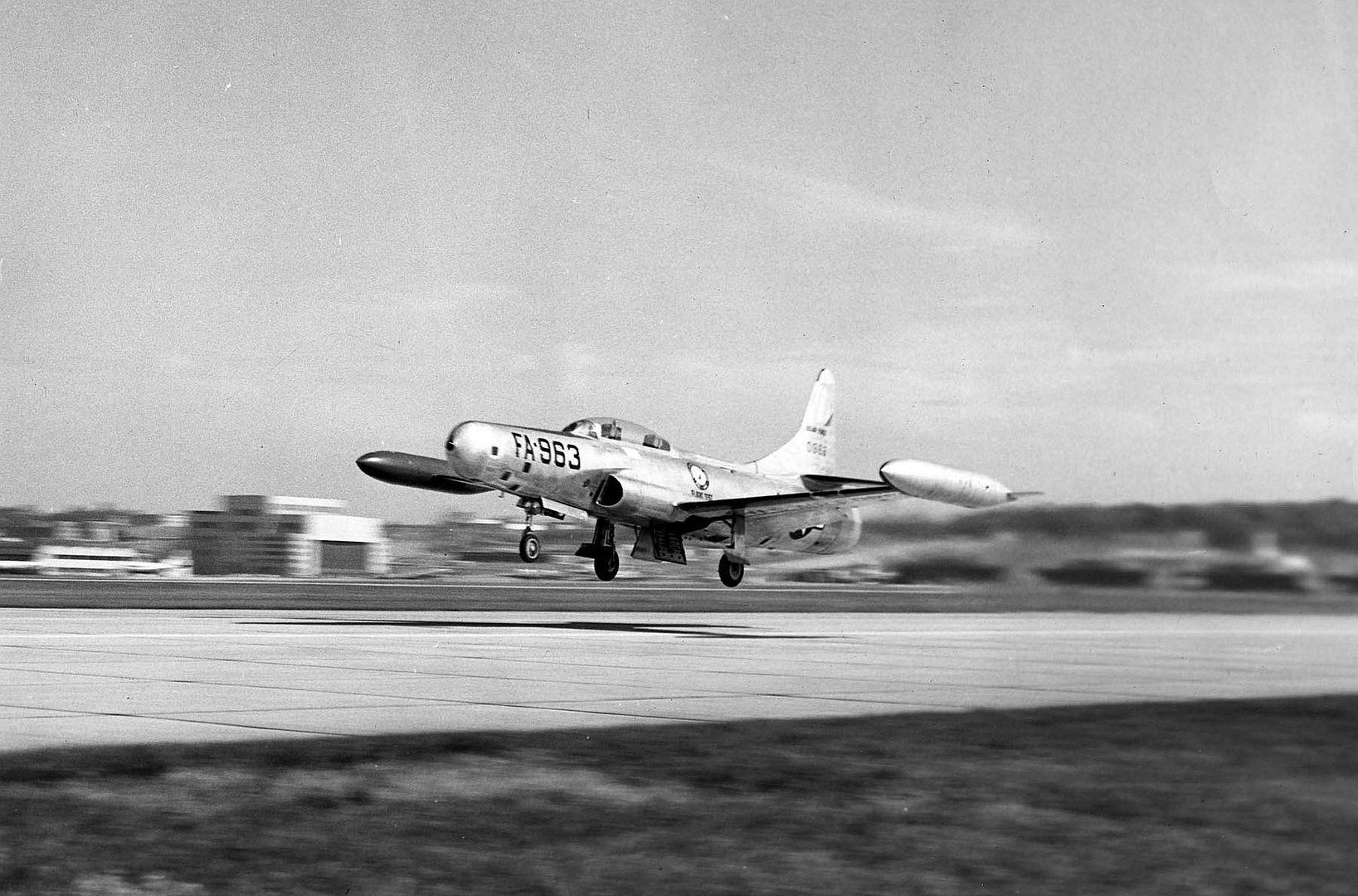
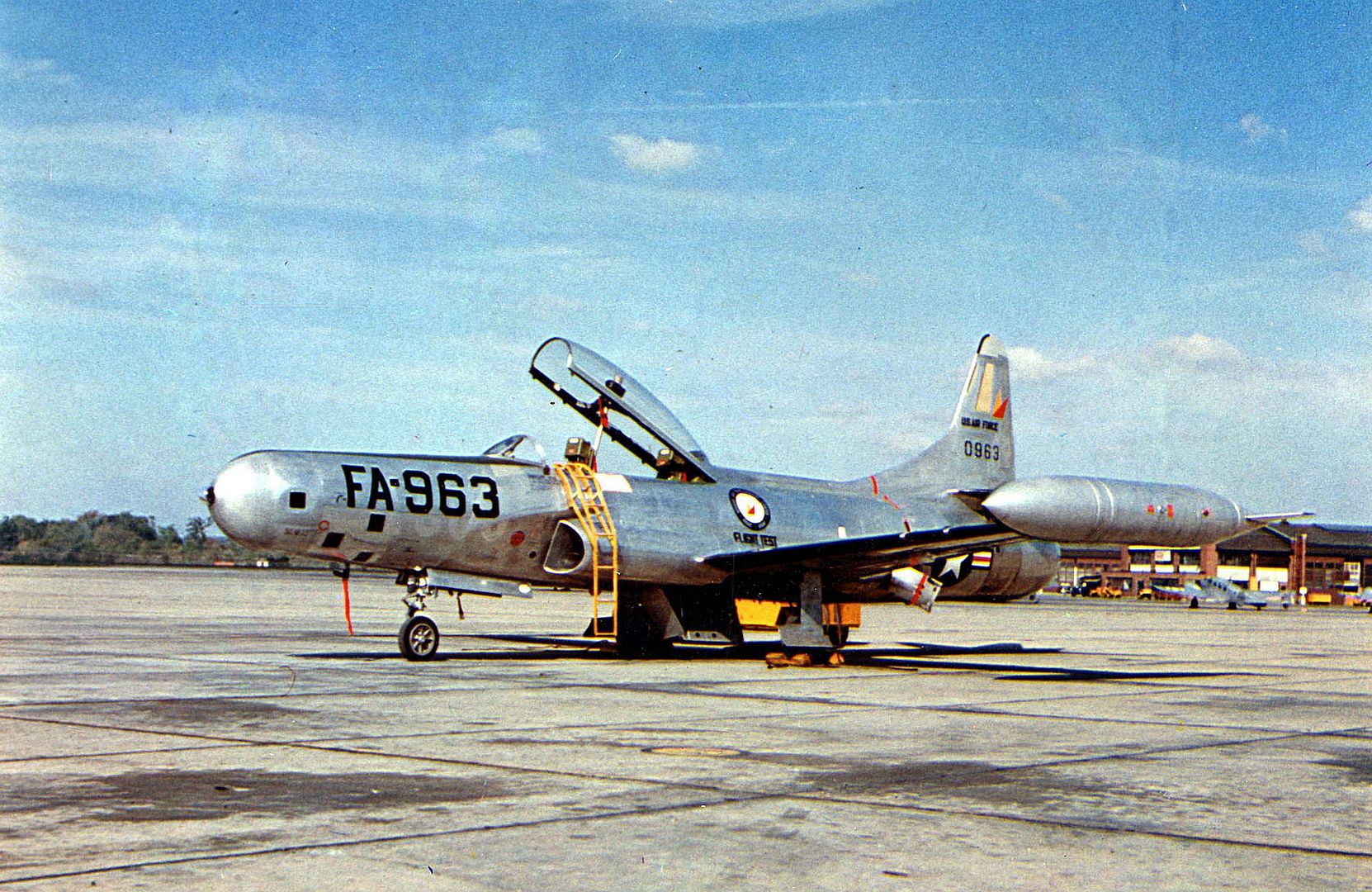
The service life of the F-94C Starfire with the USAF was quite short, most of these aircraft being phased out and replaced by more advanced types after only a half-dozen years of service. The last F-94C left USAF service in February of 1959.
After leaving USAF service, F-94Cs were passed along to the Air National Guard. With the F-94Cs supplementing the earlier F-94A/B, the Starfire equipped twenty-one Fighter Interceptor Squadrons of the Air National Guard. The last F-94Cs were phased out of ANG service by the 179th Fighter Interceptor Squadron at the Duluth Municipal Airport, Minnesota during the summer of 1959.

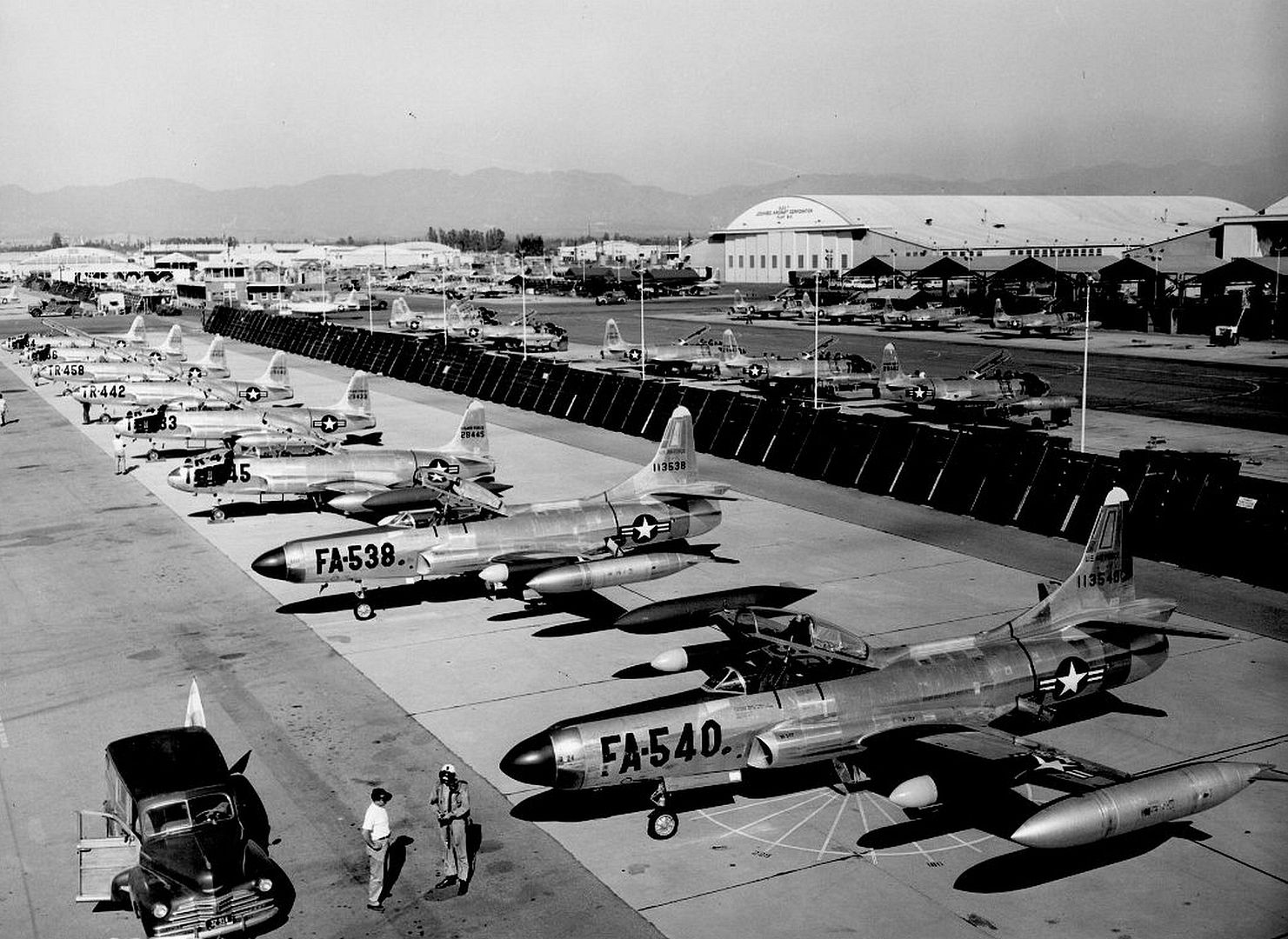
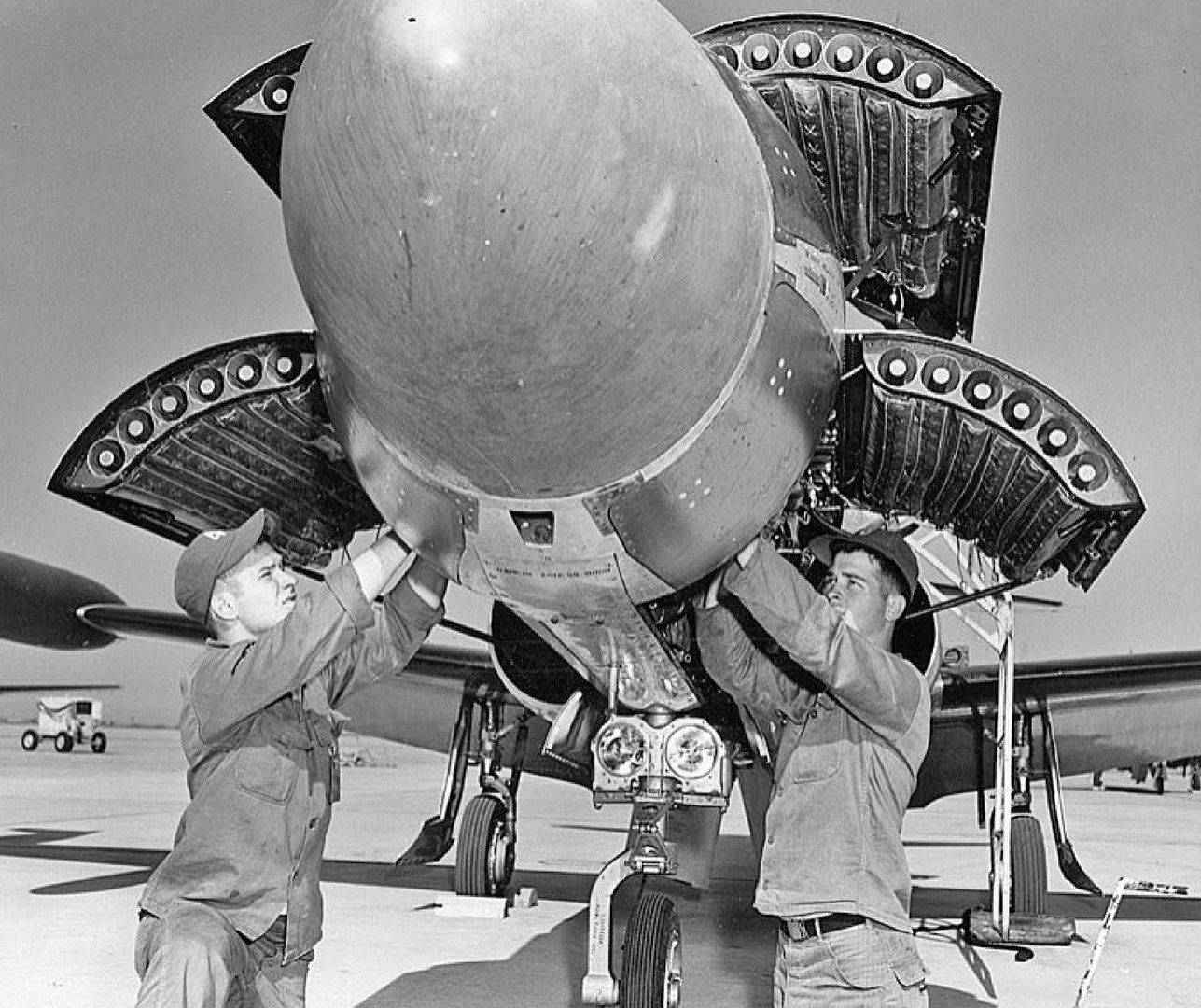
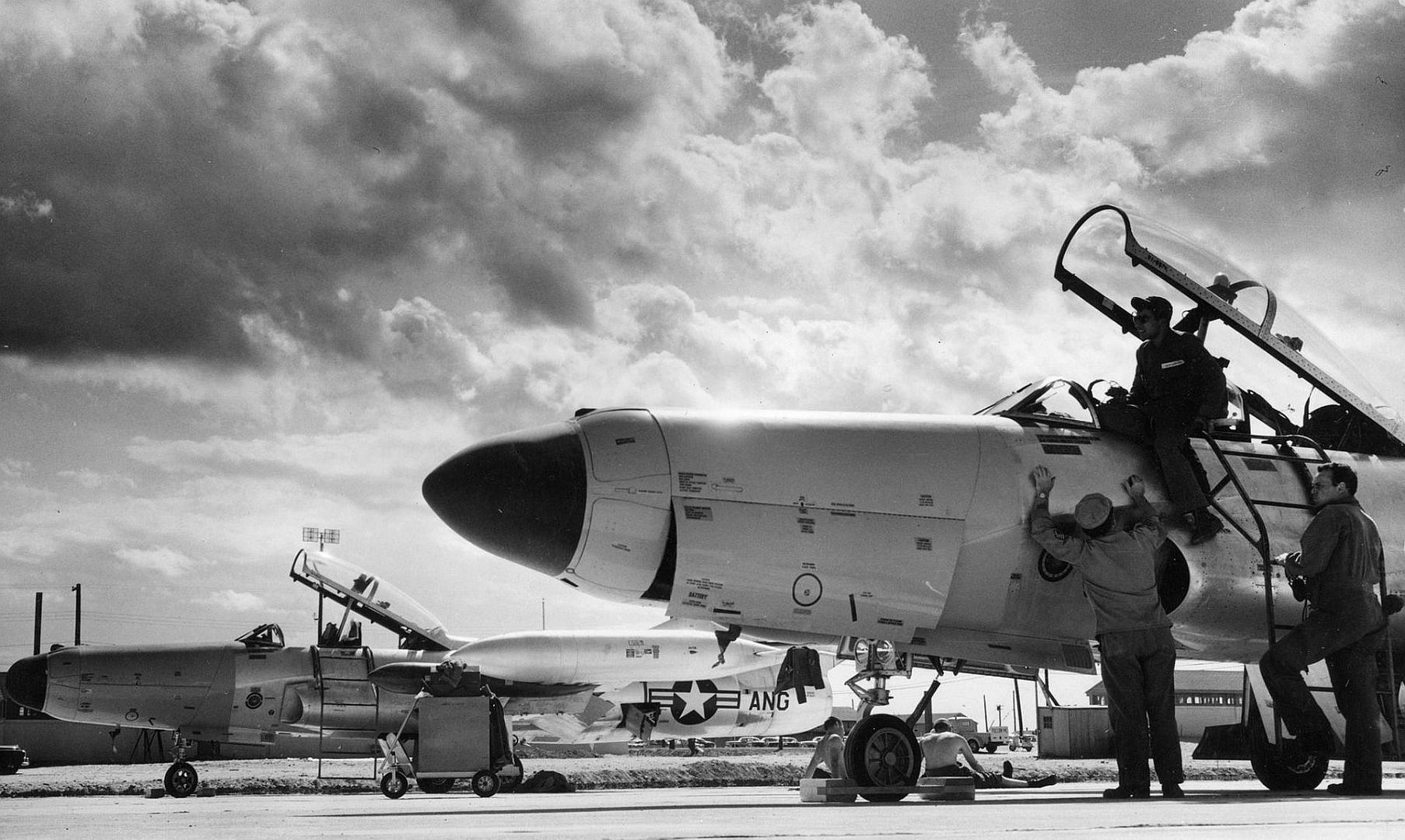
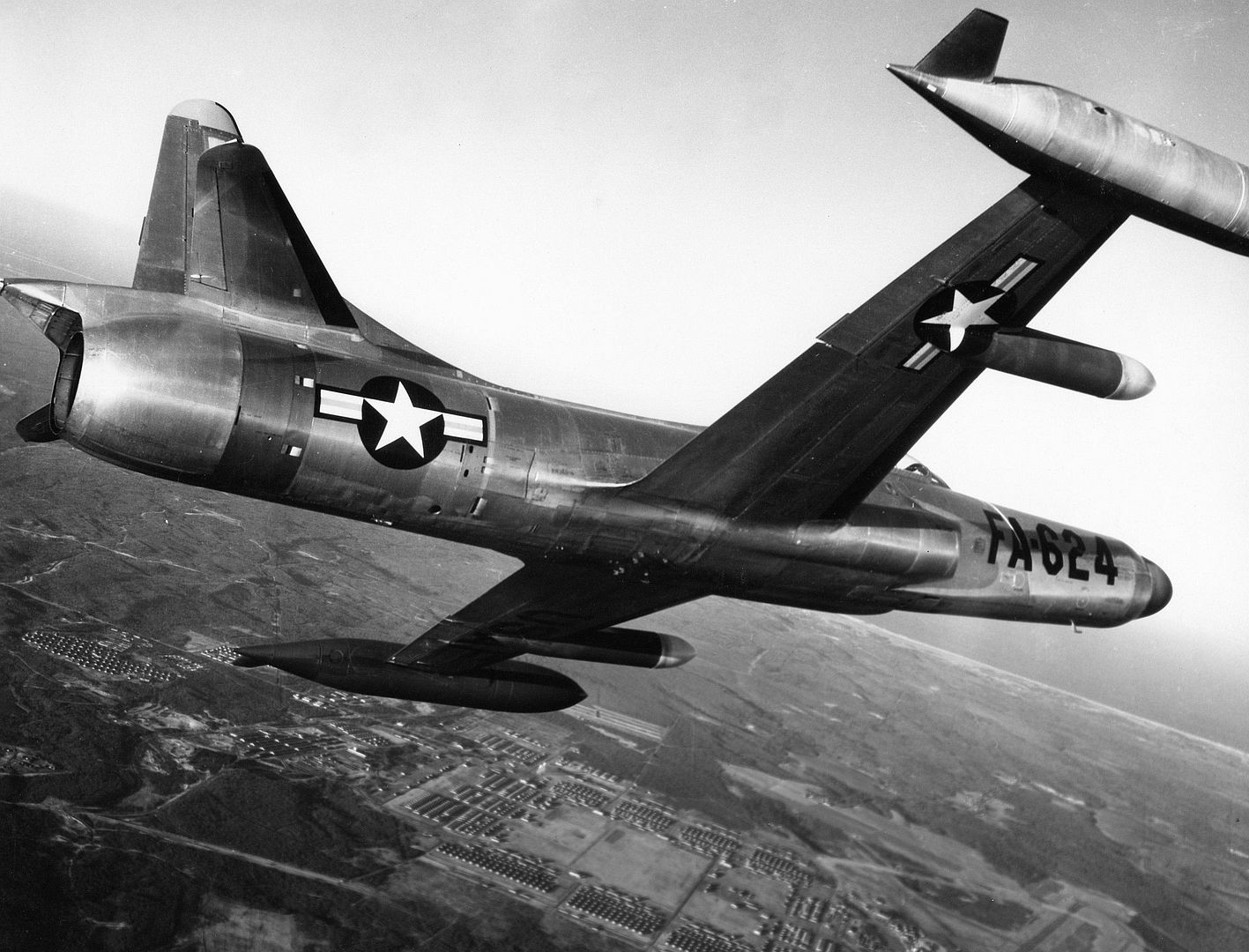
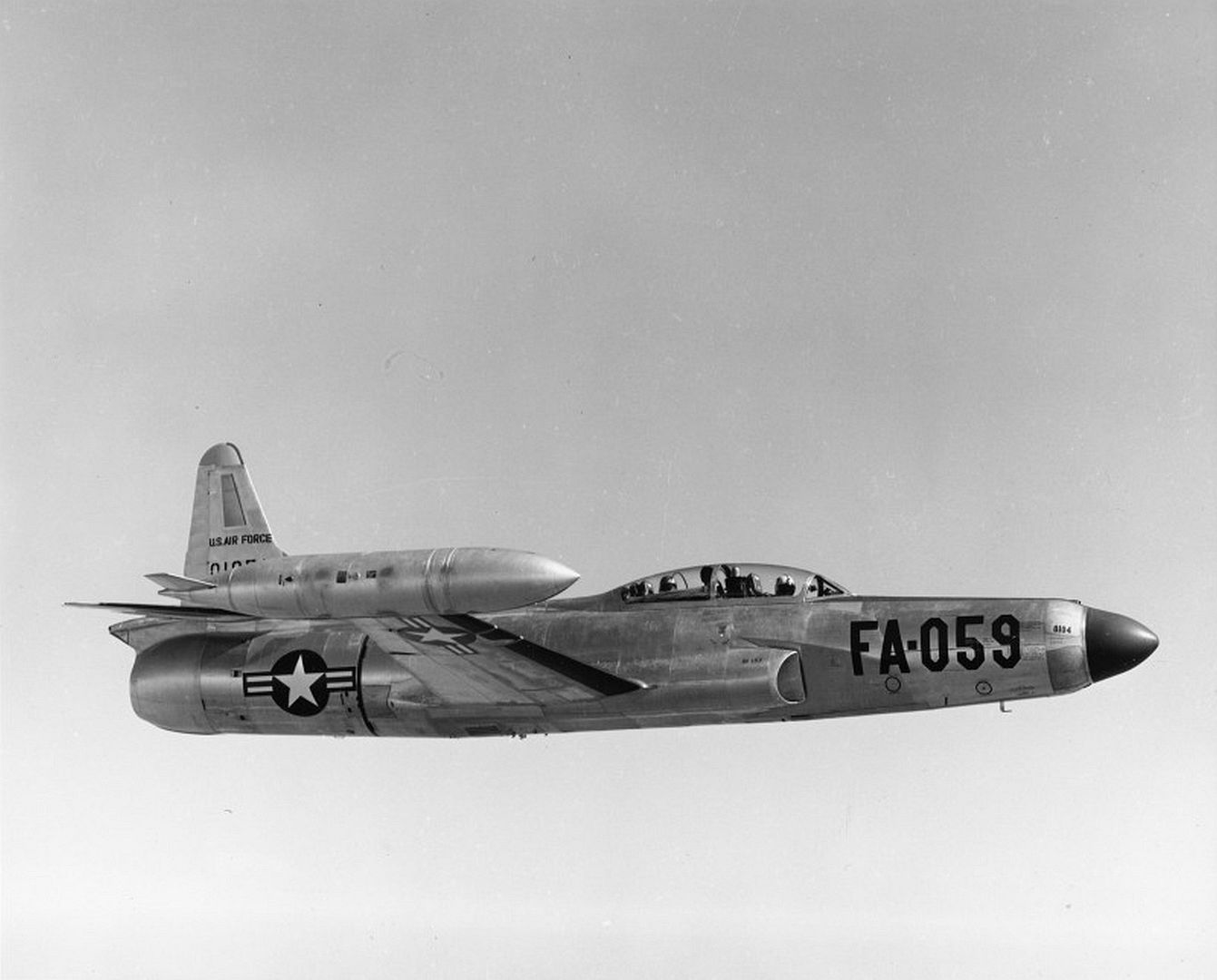
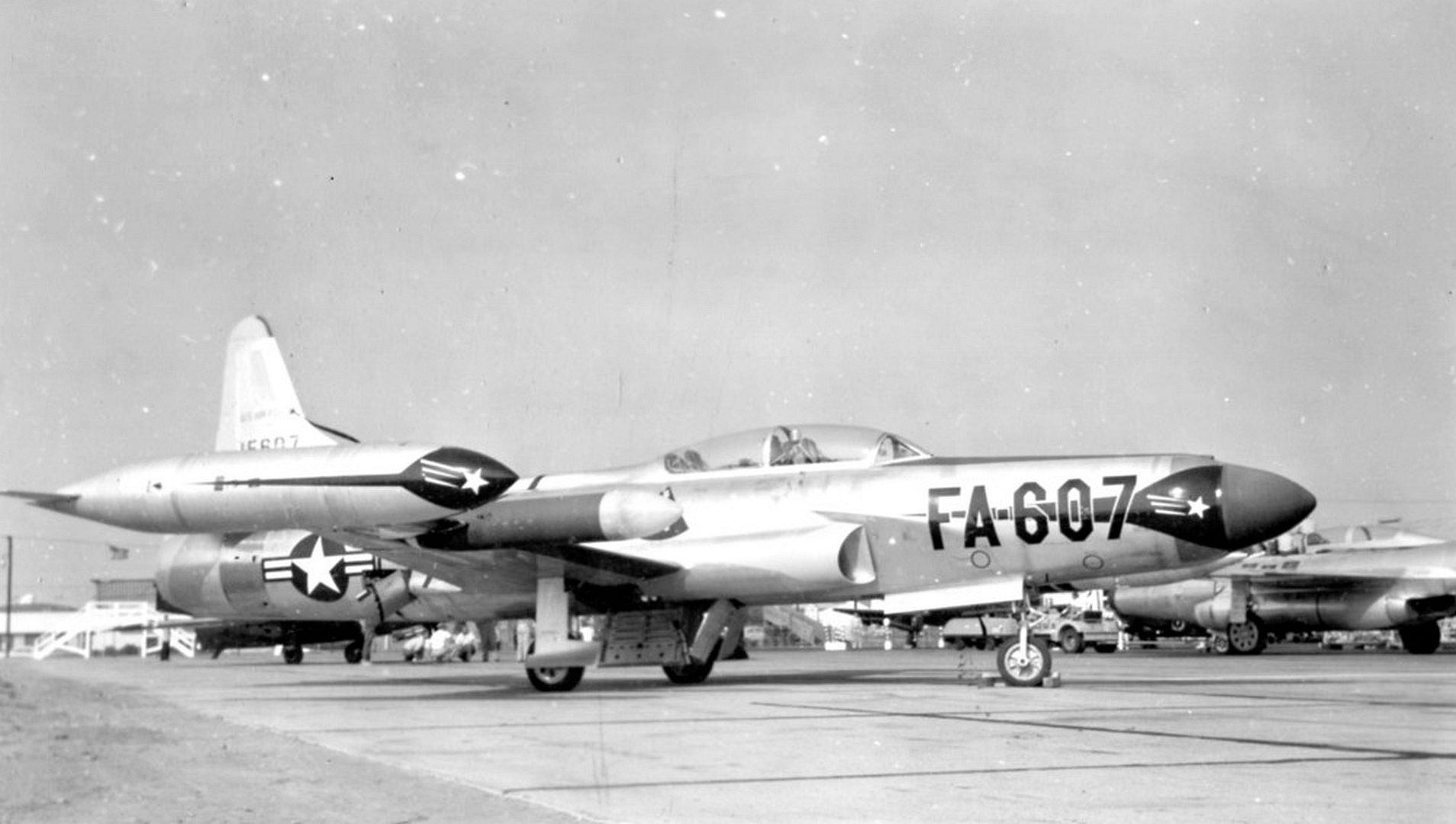
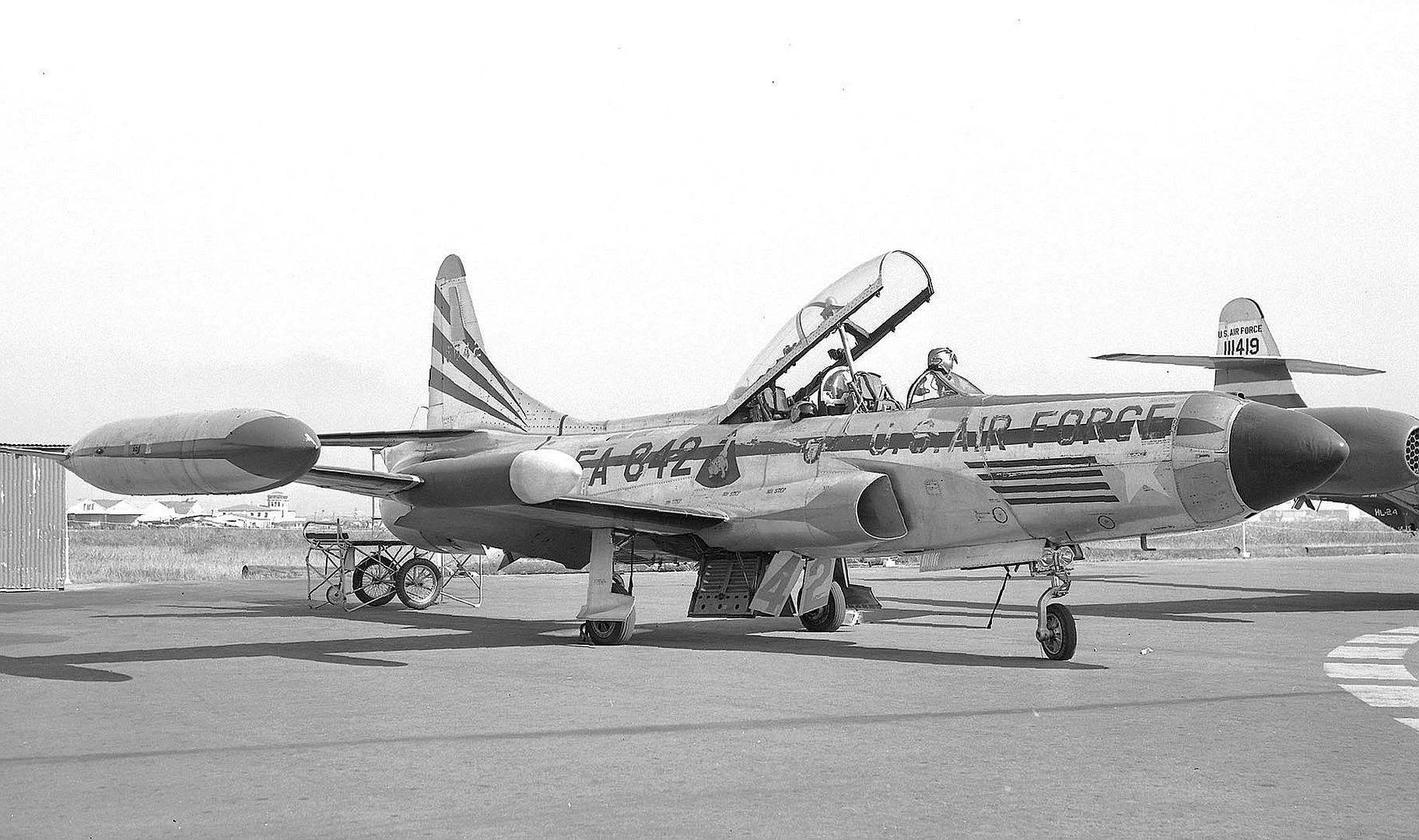

.jpg?width=1920&height=1080&fit=bounds)

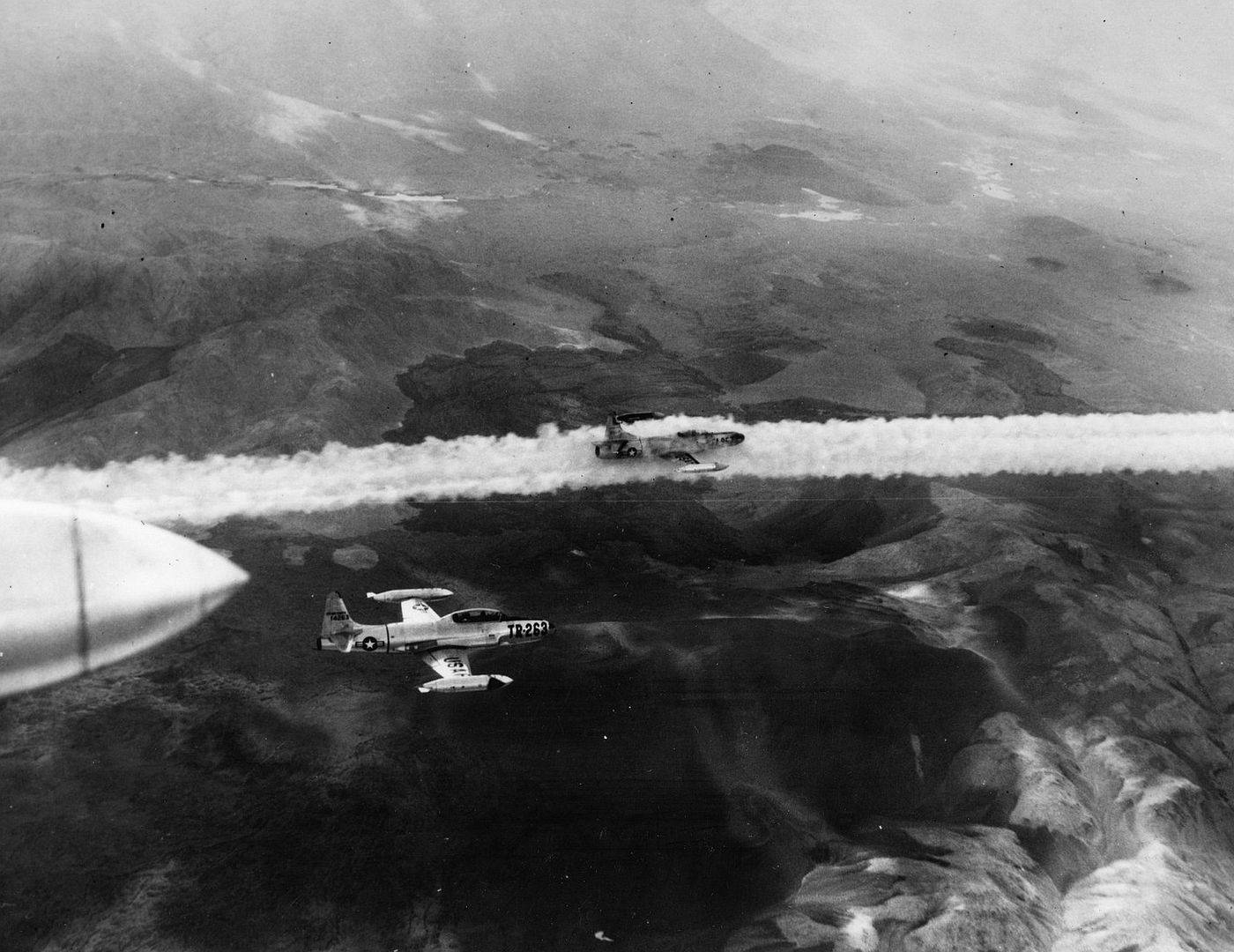
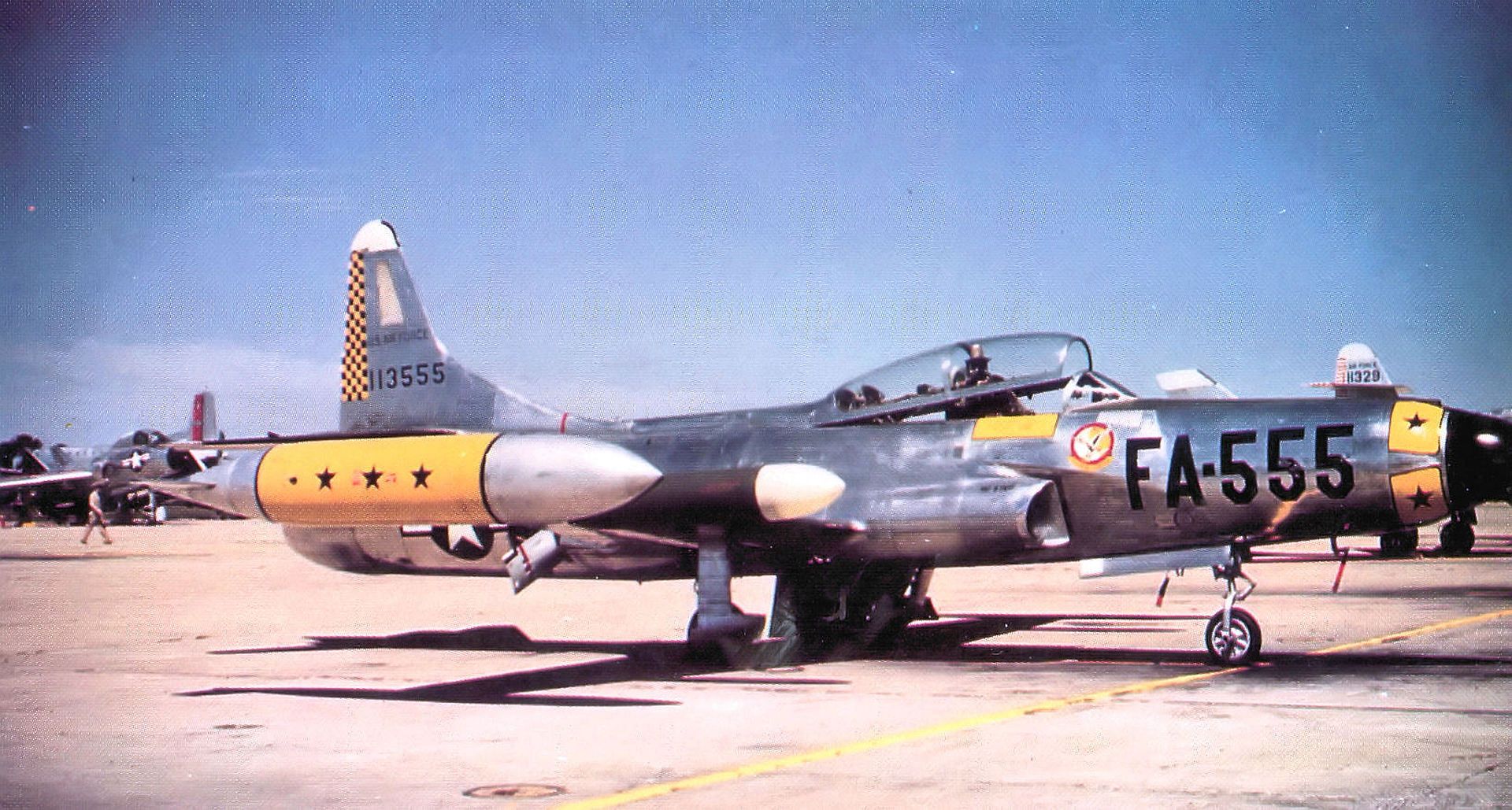

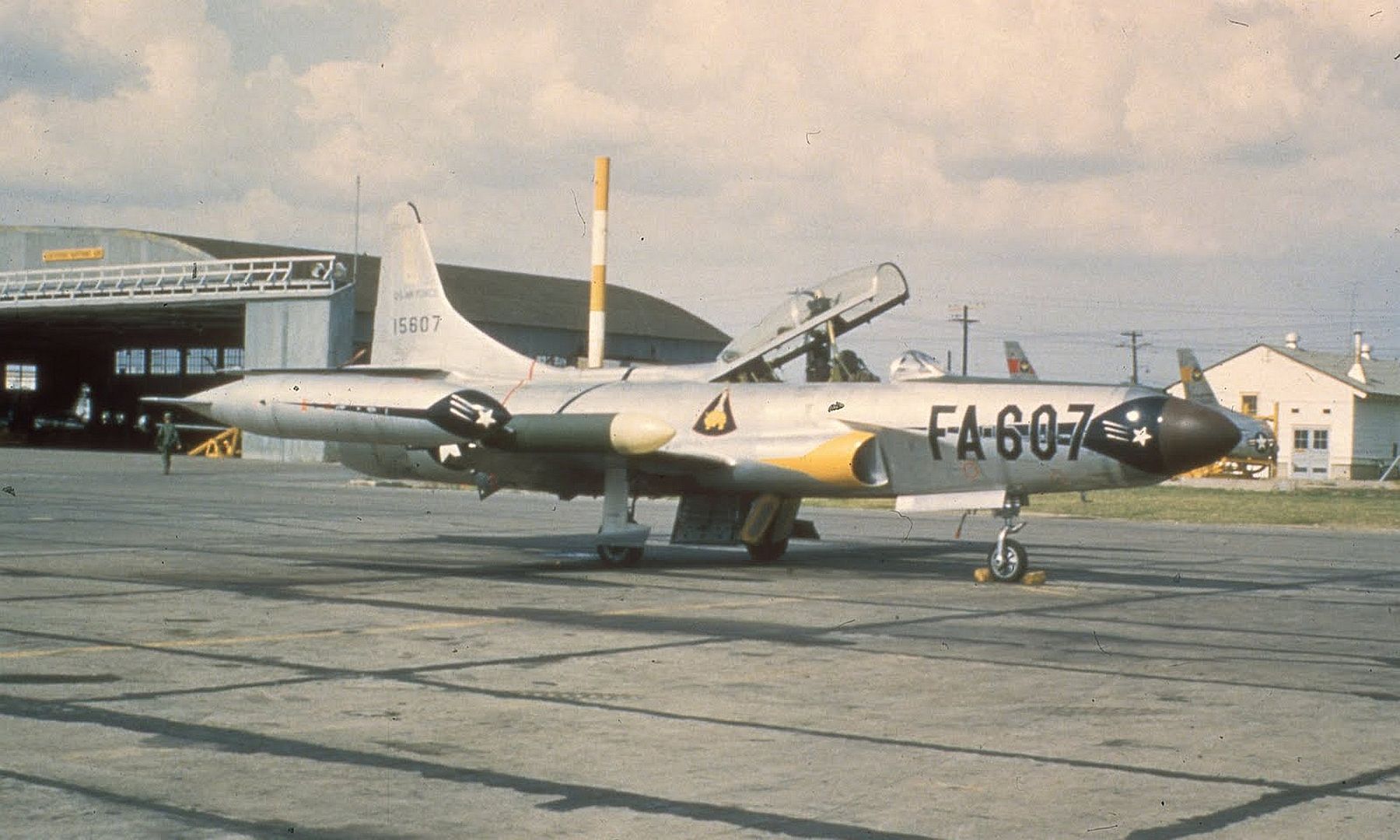
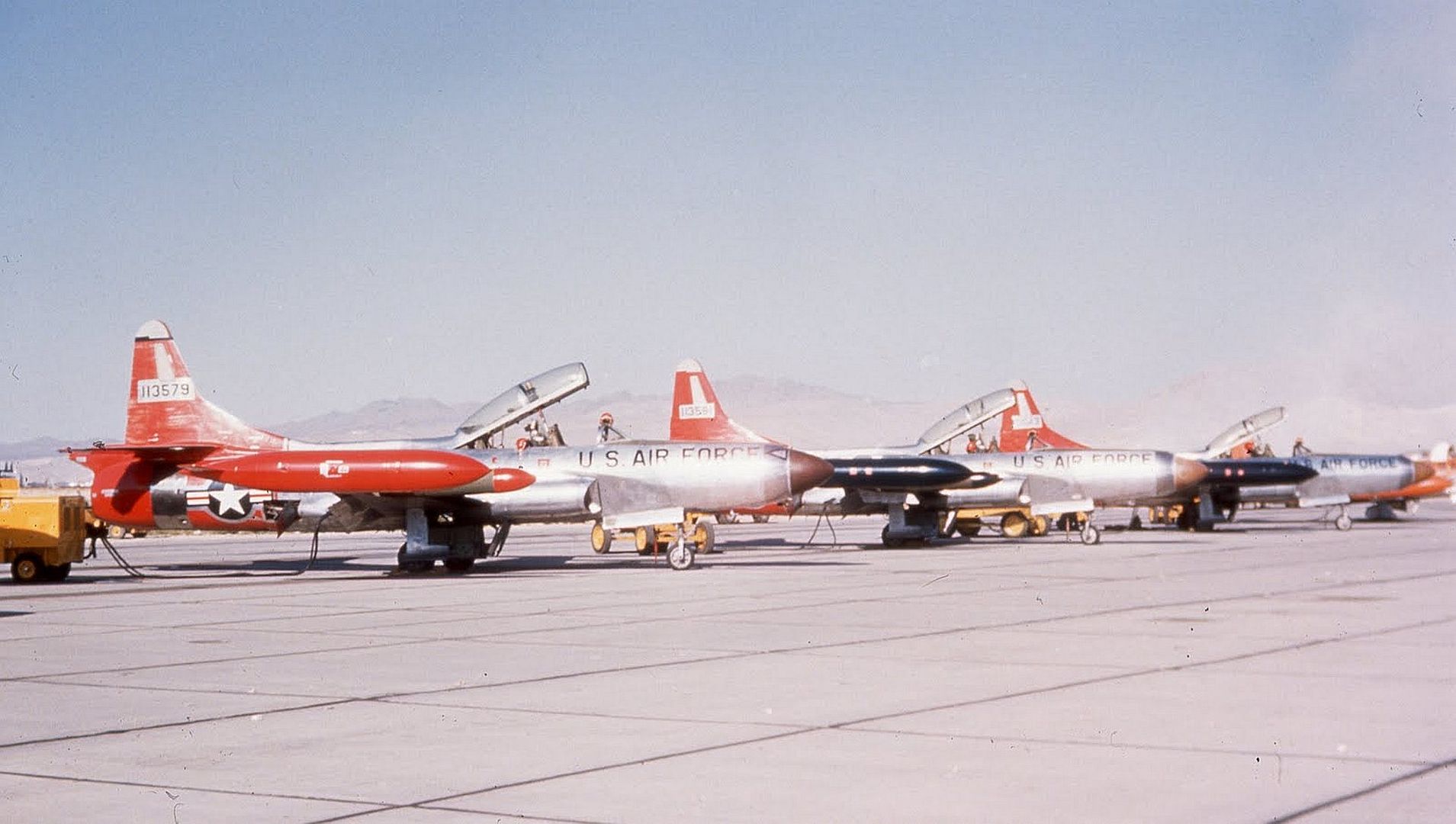
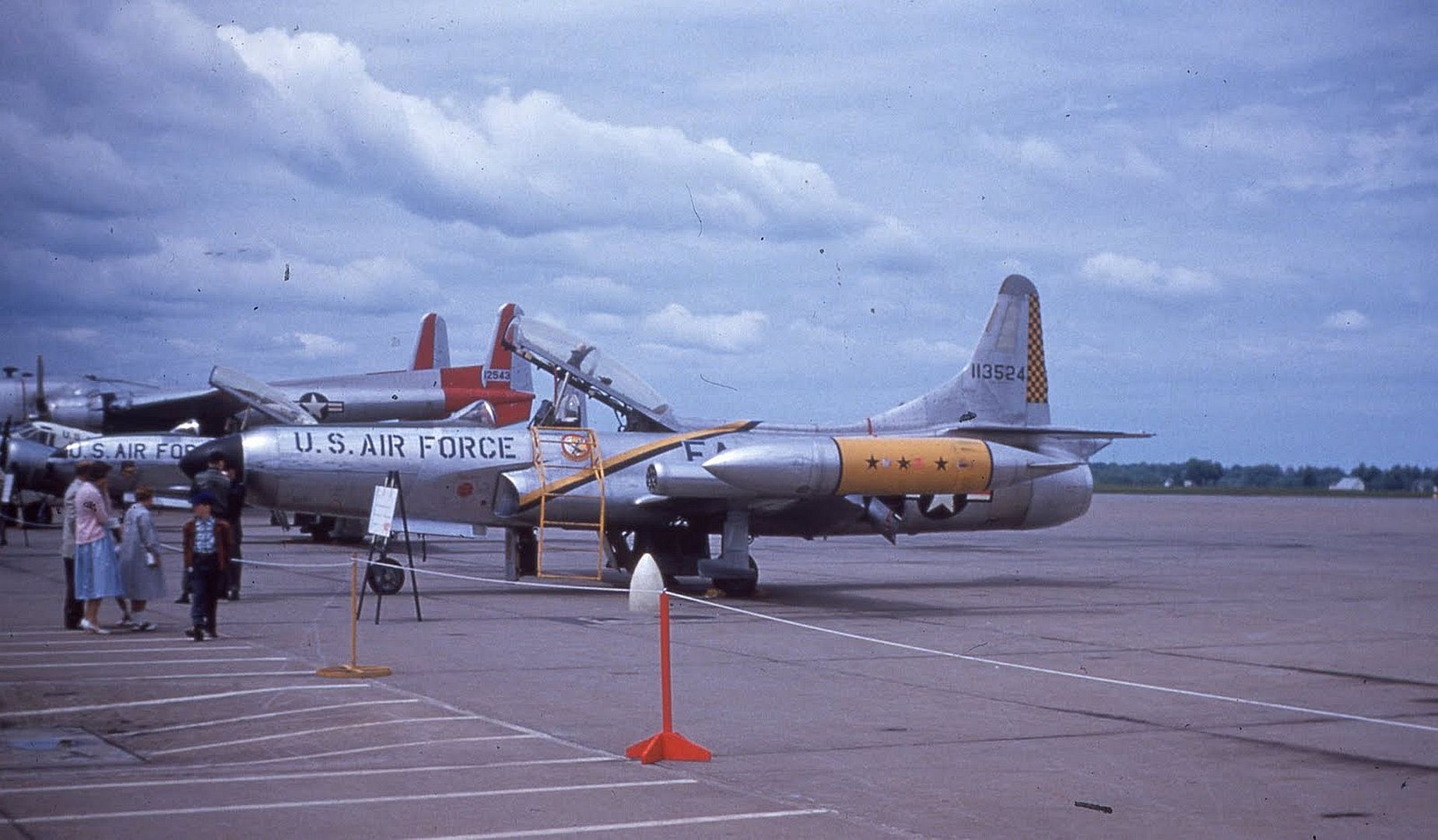
_of_the_354th_Fighter_Interceptor_Squadron_Oxnard_Air_Force_Base_Calif._on_June_19_1956..jpg?width=1920&height=1080&fit=bounds)
Serials of the F-94C Starfire:
50-877 Lockheed YF-97 Starfire -- later redesignated YF-94C
50-955 Lockheed YF-97 Starfire -- later redesignated YF-94C
50-956/1063 Lockheed F-94C-1-LO Starfire
51-5513/5698 Lockheed F-94C-1-LO Starfire
51-13511/13603 Lockheed F-94C-1-LO Starfire
Specification of the F-94C:
Engine: One Pratt & Whitney J48-P-5 turbojet engine rated at 6350 lb.st. dry and 8750 lb.st. with afterburning. Dimensions: Wingspan 42 feet 5 inches with wingtip tanks, length 44 feet 6 inches, height 14 feet 11 inches, wing area 232.8 square feet. Weights: 12,708 pounds empty, 18,300 pounds loaded, 24,184 pound maximum. Performance: Maximum speed: 640 mph at sea level, 585 mph at 22,000 feet, 578 mph at 40,000 fee. Initial climb rate 7980 feet per minute. Service ceiling 51,400 feet. Normal range 805 miles, maximum range 1275 miles. Armament: Armed with twenty-four 2.75-inch Mighty Mouse FFARs in nose, plus twelve FFARs in each of two wing leading-edge pods.
Lockheed F-94D
The F-94D was the designation applied to a proposed but unbuilt single-seat fighter-bomber version of the F-94C Starfire.
In January of 1951, Lockheed was awarded a contract for 113 Model 980-75-14 single-seat fighter-bomber adaptations of the F-94C two-seat all-weather fighter. The designation was F-94D. Serials were 51-13604 through 13716. The fuselage, tail surfaces and J48 powerplant of the F-94C were to be married to a new wing with 50 percent more area. The rear radar operator's position was to be removed and replaced by additional fuel tanks. 320-gallon wingtip and pylon tanks were to be used, bringing total fuel capacity to 1965 US gallons. A retractable inflight refuelling probe was to be installed in the upper nose. The rocket armament in the nose was to be replaced by eight 0.5-inch machine guns. The radar fire control system of the F-94C was to be replaced with ranging radar. Up to 4000 pounds of ordinance were to be carried on additional underwing racks.
In order to gain some flight test information, two aerodynamic configuration prototypes for the F-94D were obtained by fitting the new F-94D nose to a pair of F-94B-5-LOs (serial numbers 51-5500 and 51-5501). 51`-0500 was fit5ted 2ith four 0.50-inch macine guns and 51-5501 with possibly as many as six guns. This was essentially the same armament as that which was fitted to the F-94B, but with the guns being mounted higher up on the nose.
Aircraft 51-13604 was almost complete to serve as the prototype YF-94D when the USAF cancelled the entire F-94D program on October 15, 1951. The reason given by the USAF was that they wanted Lockheed to concentrate its full efforts on the F-94C program.
After the cancellation of the F-94D program, 51-5500 was used as a testbed for the General Electric T-171 (later M61A1) Vulcan rotary cannon.-modified_as_YF-94D_of_the_101st_FIS_102nd_TFW_MASS-ANG_Logan_International_Airport_East_Boston.jpg?width=1920&height=1080&fit=bounds)
Serials of F-94D Starfire
51-13604 Lockheed YF-94D-1-LO Starfire - cancelled
51-13605/13716 Lockheed F-94D-1-LO Starfire - cancelled
Text from here - https://www.joebaugher.com
Post a reply
- Go to Previous topic
- Go to Next topic
- Go to Welcome
- Go to Introduce Yourself
- Go to General Discussion
- Go to Screenshots, Images and Videos
- Go to Off topic
- Go to Works in Progress
- Go to Skinning Tips / Tutorials
- Go to Skin Requests
- Go to IJAAF Library
- Go to Luftwaffe Library
- Go to RAF Library
- Go to USAAF / USN Library
- Go to Misc Library
- Go to The Ops Room
- Go to Made in Germany
- Go to Campaigns and Missions
- Go to Works in Progress
- Go to Juri's Air-Raid Shelter
- Go to Campaigns and Missions
- Go to Works in Progress
- Go to Skinpacks
- Go to External Projects Discussion
- Go to Books & Resources
